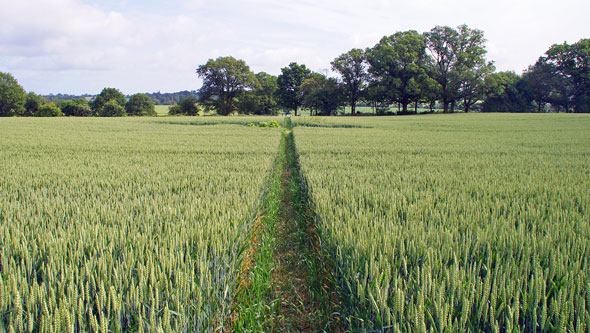|
|
|
| |
Great Eastern Railway Branch Line
All images link to larger
copies which will open in a new window/tab
|
|
|
The Epping-Ongar Railway is a preserved branch line
in Essex. The railway was part of a 10km stretch at the end of the Great
Eastern, latterly LNER and London Underground Central Line. After London
Underground suspended passenger services in 1994, the line was preserved as
a heritage railway. A weekend diesel shuttle service ran from 2004 till
2007, but it was then decided to improve the infrastructure of the line to
increase the frequency of trains and to enable locomotives to operate,
ensuring the long term future of the line, reopening on 25th May 2012. See
the
Official
Epping Ongar Railway Website for
the latest details.
The connection to Ongar was made in 1865 by the Eastern Counties/Great
Eastern Railway. The eastern section of the line, between Epping and Ongar,
was always single track, with just one passing loop at North Weald station,
and approximately 14 trains each day went as far as the rural station, with
the rest terminating at Epping or Loughton.
This remained the case until 1949, when the London Transport Passenger
Board's New Works scheme extended the Central Line to Epping using electric
trains (taking over the railway from British Rail). The Epping-Ongar branch
lost its through trains to London, and a shuttle service between Epping (to
connect with trains to London) and Ongar was implemented. For a short time,
one could see the unusual sight of steam trains and London Underground
electric multiple units side-by-side at Epping.
The 1950s saw attempts to improve the service on the branch, and eventually
the line was given light electrification in 1957. The low-cost nature of the
electrification meant that the branch could only support short trains - the power supply was simply not sufficient to support
full-size trains, and the short platforms on the branch line would not have
been long enough to support eight-car trains. Hence, the Epping to Ongar
branch was normally operated as an isolated branch of the Central Line. On
September 30, 1994, passenger services on the line, which was making a loss
of seven pounds for each passenger journey and was in need of some expensive
maintenance work, were suspended, the Central Line terminating at Epping
Station. At the time the passenger services were suspended, it was carrying
a mere 80 passengers a day. The track was left intact along with the
stations (albeit in an unmaintained state). (ref: Wikipedia)
Sections on this webpage:-
1: The Epping Ongar Railway
from 2012
2: The Epping Ongar
Railway 2004-2007
3: Epping-Ongar as a London Tube Line
For Latest Epping-Ongar Information:-
Official Epping Ongar Railway Website: eorailway.co.uk
Epping Ongar Railway facebook page
|
|
|
|
|
|
All images link to larger
copies which will open in a new window/tab
This section shows images of the railway from when it
reopened on 25th May 2012, following a press day on 24th May. Operations
were delayed the following day due to some staff being held up in major
problems on the M25 motorway. Once under way, services worked well,
effectively running as two separate single lines out of the two platforms at
North Weald. Steam ran between North Weald and Ongar with a loco at each end
of a train of five BR Mk1 and Mk2 coaches. Engines used to Ongar were the
railway's GWR Hall Class Pitchford
Hall and loaned GWR pannier tank 6430 standing in for their GWR
Prairie 4141 which was received attention to its boiler. The diesel trains
from North Weald under the M25 to Coopersale were top and tailed by Brush
Type 2 number 31 438 and shunter 03 170. The Class 31 is being prepared for
repainting. Fully restored Class 37 D6739 was used later in the first
weekend.
Whilst much work needs to completed, the restoration of platforms, station
buildings and signal boxes is of very high quality. Excellent replica gas
lamps are being installed at both stations and even road to North Weald.
Long term plans include a new station at Epping, linked by footpath to the
Underground station. Everything suggests this will become a very important
preserved line in an area where the nearest similar line is some distance
away (excluding steam centres and very short lines) and it is also the
closest to London.
For Latest Epping-Ongar Information:-
Official Epping Ongar Railway Website: eorailway.co.uk
Epping Ongar Railway facebook page
4953 Pitchford Hall - 4-6-0
Pitchford Hall is a member of the GWR 4900
Hall Class of locomotives, designed by Charles Collett. 259 locomotives of
this class were built, and the design is said to have heavily contributed to
LMS Standard 5 and LNER Thompson B1 classes. The class latterly received a
5MT power classification under BR. 11 examples have been saved for
preservation, several have made it back onto the mainline, including
Pitchford Hall and one of which, Olton Hall, has gained
international fame through becoming the 'Hogwarts Express' locomotive.
Pitchford Hall was built at Swindon in
August 1929 at a cost of £4,375, and was first allocated to Bristol, Bath
Road shed. Latterly in August 1950 it was transferred to Cardiff Canton and
fitted with BR type piston valves and liners February 1956 but reverted back
to WR standard within two years. In March 1959 she was allocated to Swindon
and then transferred from Cardiff Canton to Cardiff East Dock shed in
September 1962. Her last years were spent at Cardiff East Dock before being
withdrawn in May 1963 having covered 1,344,464 miles, and was sent to
Woodham's Brothers Scrapyard in Barry in November 1963.
Pitchford Hall was the 150th departure from
Barry in February 1984, when it was taken to Tyseley Locomotive Works where
a comprehensive overhaul was undertaken for a reportedly seven figure sum.
She moved again under her own power in February 2004, making her first
public appearance in 42 years at Crewe in September 2005, being seen by over
40,000 people.
Hall class locomotives were used all over the Great
Western and Western Region. Their duties were diverse from standing in for
failed 'Castles' on expresses (and keeping to tight schedules) to heavy
freight work and secondary passenger services. The impressive acceleration
of these engines made them particularly suited to the duties that required
frequent stops, where the smaller wheels gave greater adhesion and therefore
reduced slipping when starting from standstill.
The Hall class and other GWR 2-cylinder engines all
have a distinctive 'bark' to their exhaust notes, which is one thing that
helps to maintain enthusiasm throughout the generations. Their long service
also ensured they wore a number of liveries. This included the passenger
class fully lined GWR green until 1948 and nationalisation, then during the
early BR years all mixed traffic classes on all regions carried the lined
black livery. In 1956 some discretion was allowed by BR, and the Western
Region was allowed to paint mixed traffic engines in fully lined Brunswick
green.
Pitchford Hall returned to the mainline in December
2005, and operated a number of special mainline charter trains during 2007
and 2009, but has also visited a number of heritage railways, including West
Somerset Railway, Llangollen (where it double-headed with City of Truro),
Mid Hants Railway (standing in for King Edward II) and
Great Central
Railway, where it has hauled passenger as well as charter freight and even
demonstration Travelling Post Office trains to the delight of visitors.
Ref:-
Epping Ongar Railway Website: eorailway.co.uk
4953 Pitchford Hall at
Loughborough Central on the
Great Central Railway
Photo: © Ian Boyle, 25th September 2011
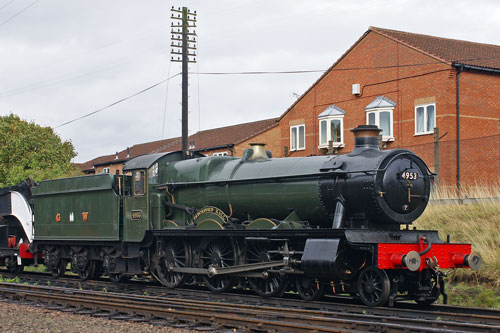
GWR Hall Class 4953
Pitchford Hall at Ongar
Photo: © Ian Boyle, 25th May 2012
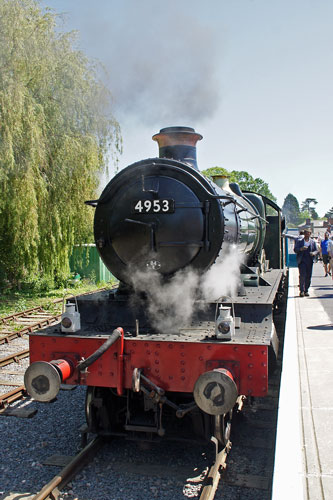
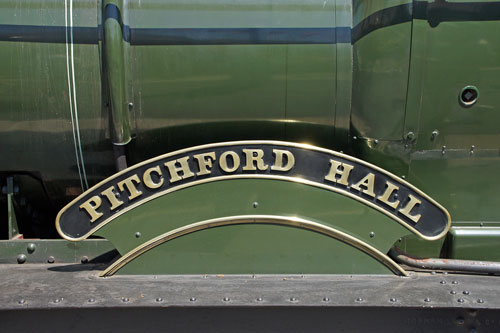
GWR Hall Class 4953
Pitchford Hall at North Weald
Photo: © Ian Boyle, 25th May 2012
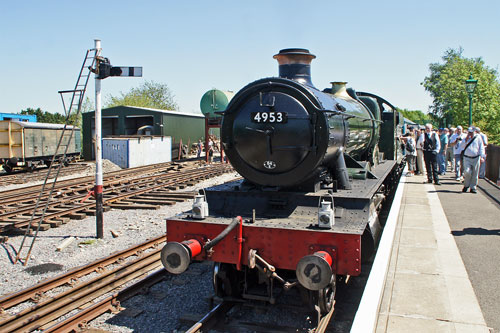
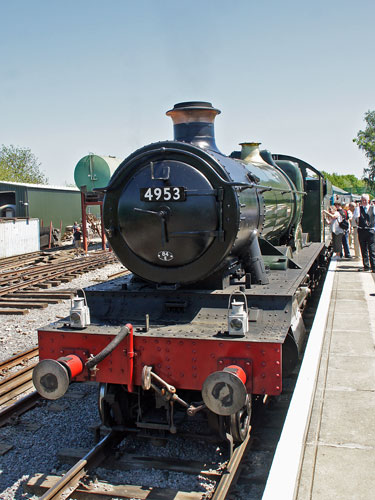
GWR Hall Class 4953
Pitchford Hall leaving North Weald (towed by 6430)
Photo: © Ian Boyle, 25th May 2012
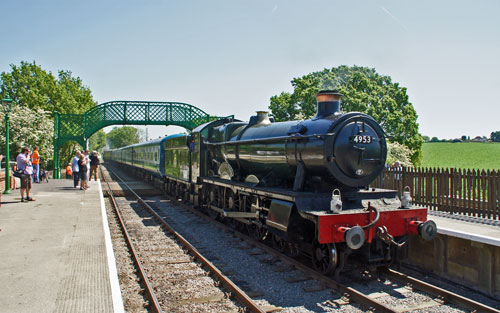
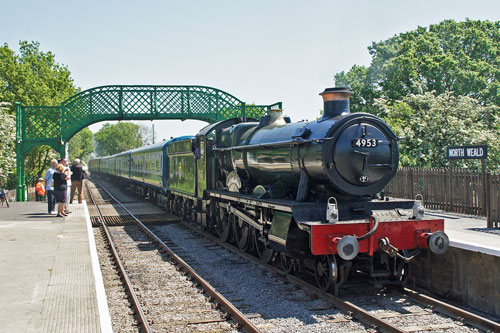
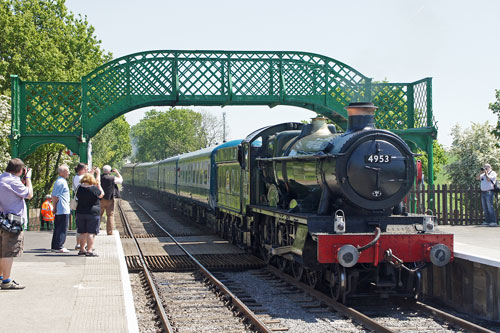
GWR Hall Class 4953
Pitchford Hall arriving at North Weald
Photo: © Ian Boyle, 25th May 2012
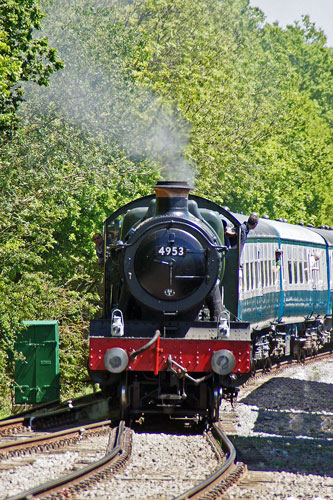
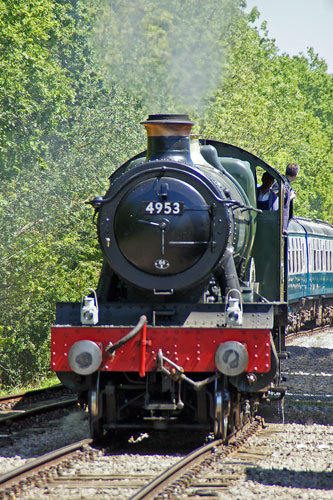
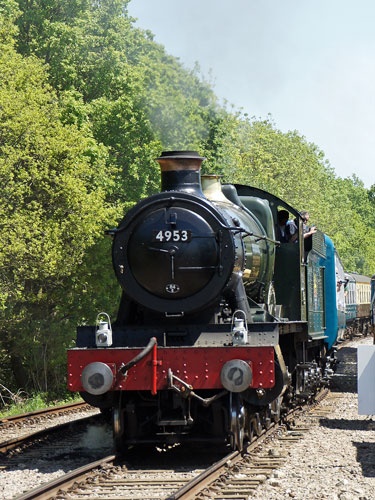
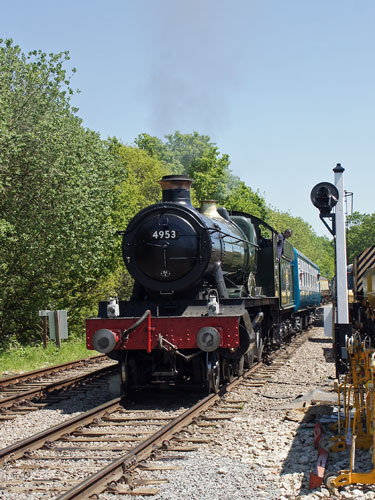
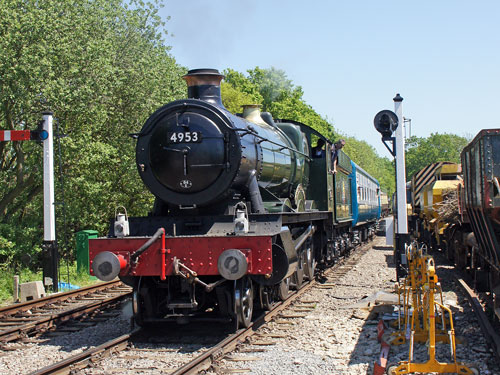
GWR Hall Class 4953
Pitchford Hall arriving at North Weald
Photo: © Ian Boyle, 25th May 2012
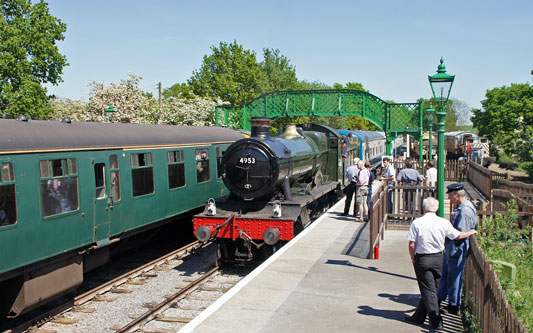
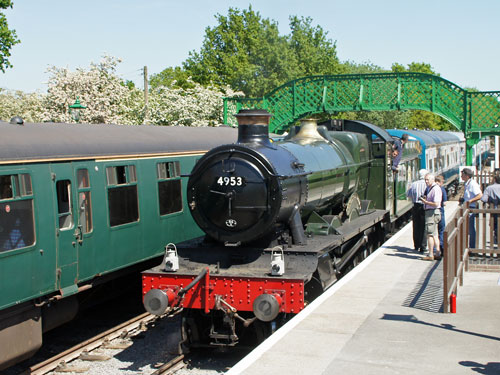
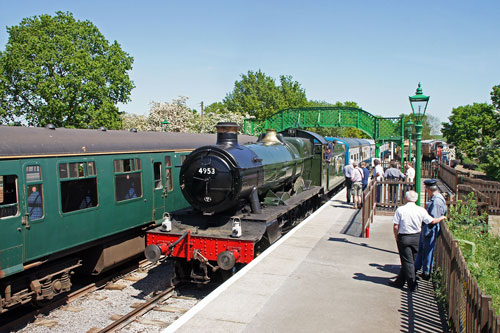
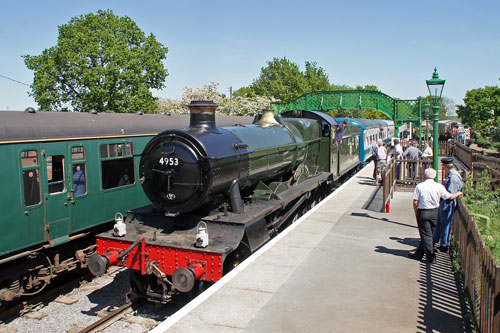
GWR Hall Class 4953
Pitchford Hall - tender emblem
Photo: © Ian Boyle, 25th May 2012
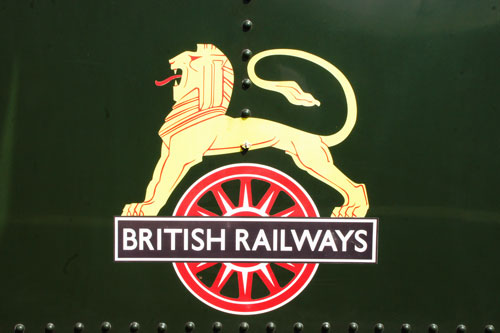
4141 is a member of the GWR 5101 class, commonly
known as a Large Prairie, being 41ft (12.5m) in length and 79.71 tonnes. It
is a medium sized tank engine with a 2-6-2T wheel arrangement and was
designed for suburban and local passenger services, often seen with GWR and
BR suburban coaches, such as those under restoration at EOR.
The class was built between 1903 and 1949, and
totalled 209 examples. 4141 was built in Swindon in 1946, and was allocated
to Gloucester (Horton Rd) for all of its working life, working on banking
duties before latterly working expresses to London.
Thanks to the proximity of Barry scrap yard to the
former GWR system, 10 examples were saved for preservation. 4141 was
withdrawn in February 1963 and reached Barry in November 1964, being saved
for preservation in early 1973. 4141 and its classmates have proved to be
ideally sized for use on heritage railways, handling the shorter journey
times and typical loads, being economic and reliable performers.03119 is a
unique engine as it was one of the specially modified Class 03 shunters
which was modified to have a "cut down", reduced height cab to enable it to
work the Burry Port & Gwendraeth Valley branch which had lower bridges, and
fitted with air operated controls so they could be worked in pairs to cope
with the heavy loads. Built at BR Swindon Works and introduced in September
1959 as D2119, it was allocated initially to Danygraig depot.
Renumbered to 03119 in March 1974, it was withdrawn from traffic while
allocated to Landore Depot in February 1986. After arriving at Knills scrap
yard, Barry, in November 1986, 03119 was quickly saved and moved to the Dean
Forest Railway by December 1986 to enter railway preservation. 03119 made
the move to the West Somerset Railway in March 1996, where it has been kept
in good working order by the Diesel and Electric Preservation Group at
Williton before coming to EOR in Dec 2011. The locomotive carries the BR
livery, and 03 shunters were once a common sight all over the country,
including at many East Anglian stations on shunting duties.
Ref:-
Epping Ongar Railway Website: eorailway.co.uk
GWR Prairie 4141 at North Weald
on an Ongar train
Photo: © Ian Boyle, 5th May 2013

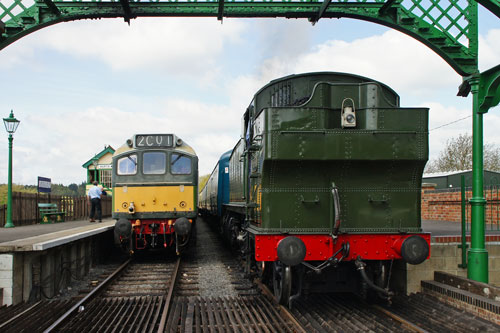
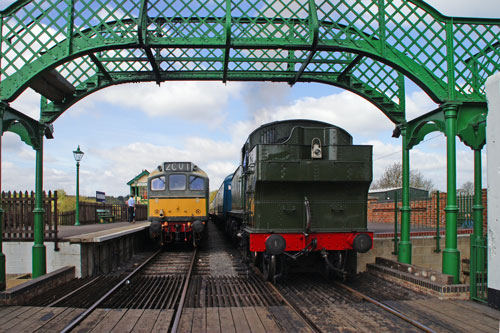
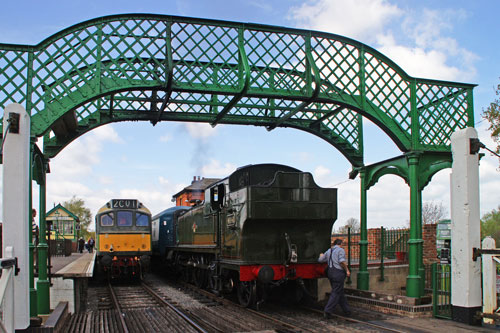
GWR Prairie 4141 arriving at
North Weald from Ongar
Photo: © Ian Boyle, 5th May 2013
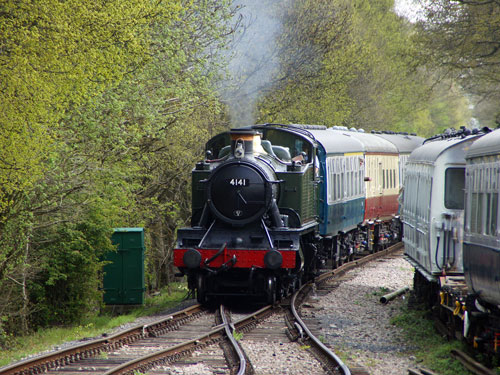
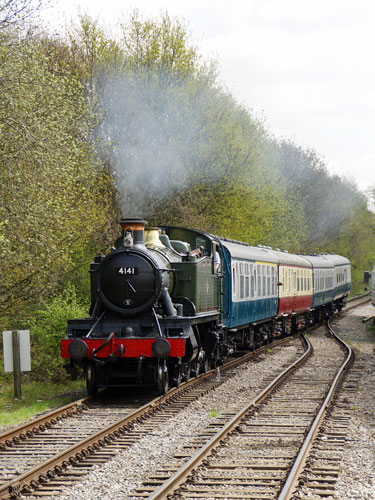
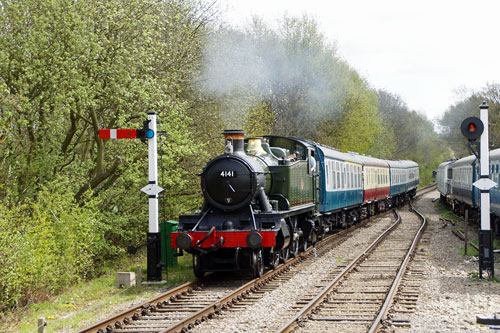
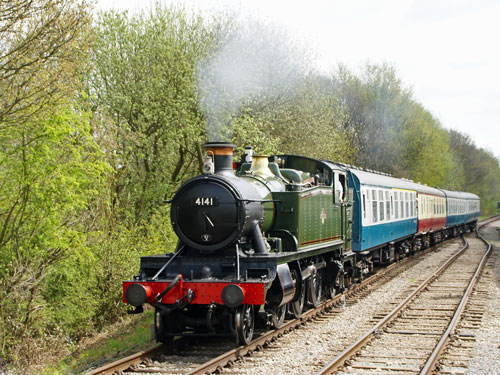
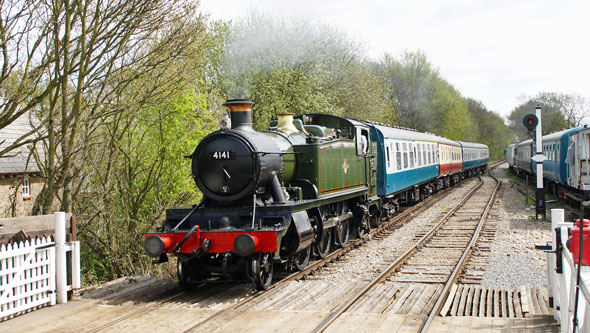
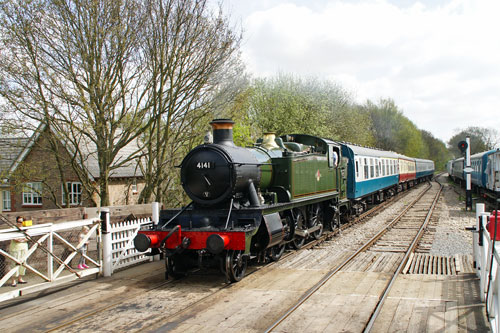
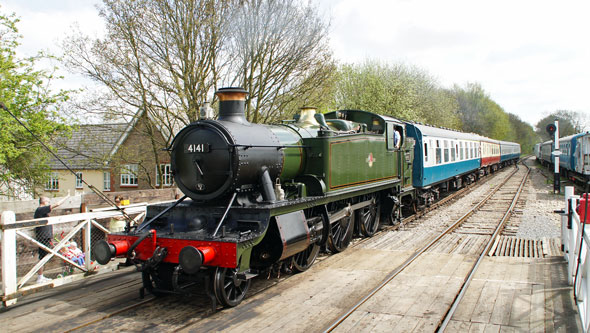
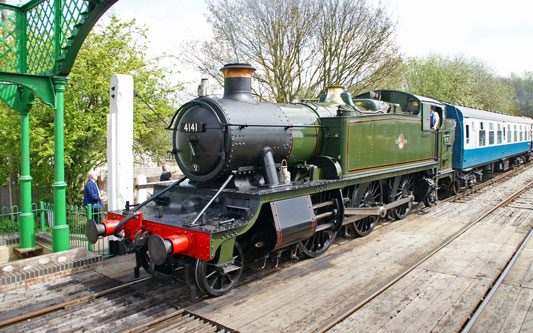
GWR Prairie 4141 running round
its train at North Weald
Photo: © Ian Boyle, 5th May 2013

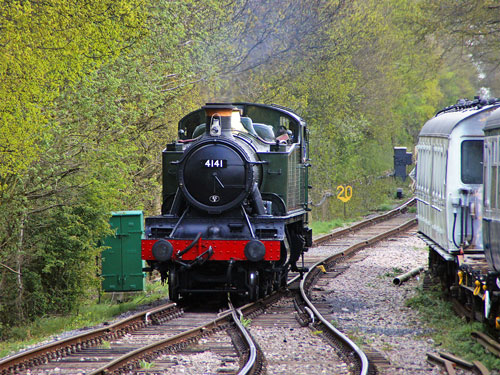
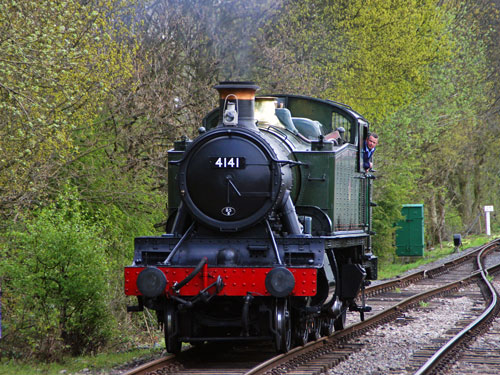
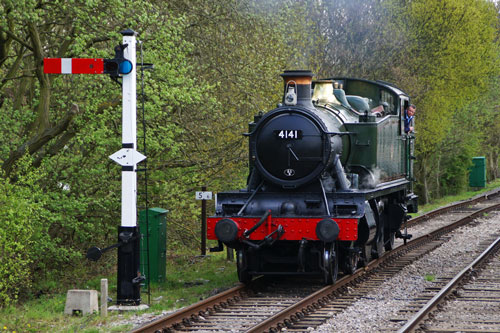
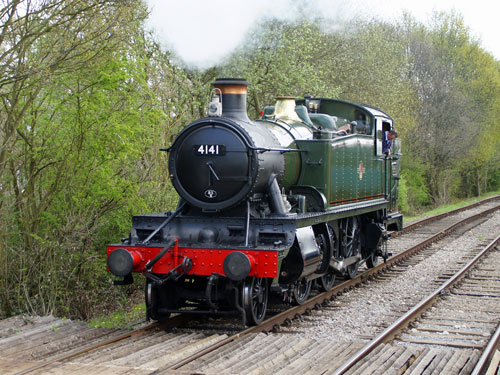
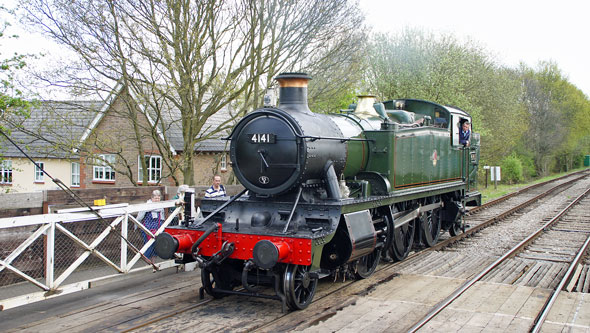

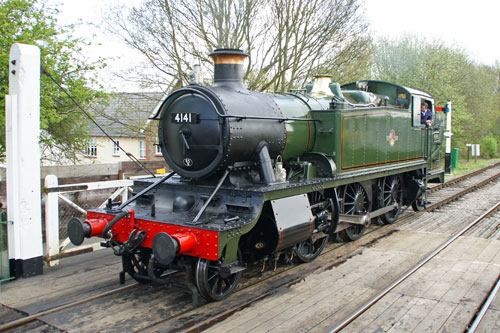
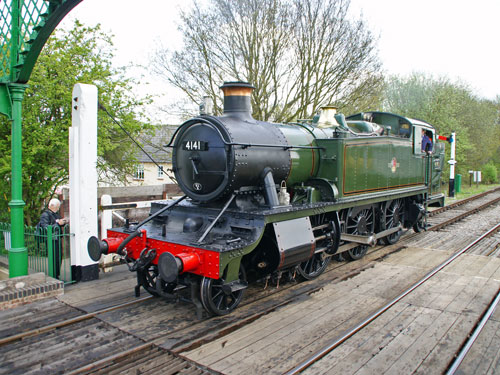
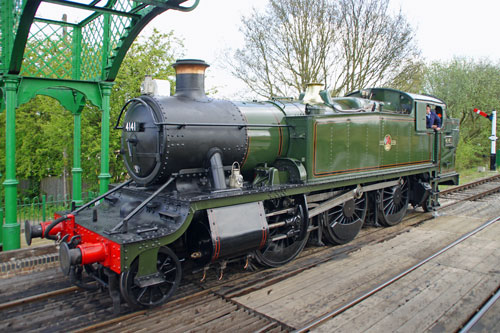
GWR Prairie 4141 running round
its train at Ongar
Photo: © Ian Boyle, 5th May 2013
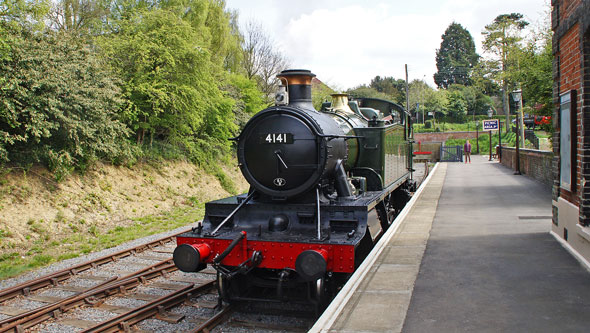
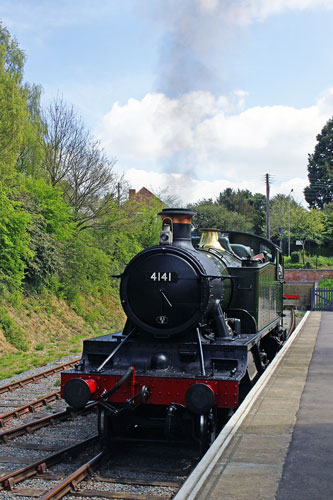

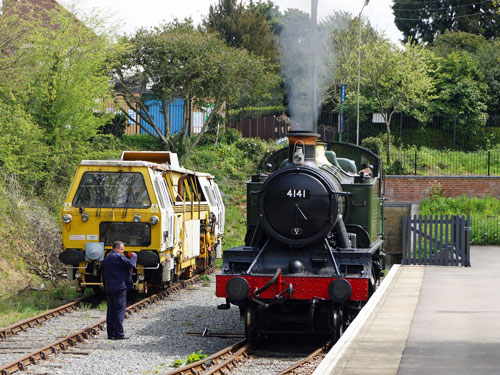
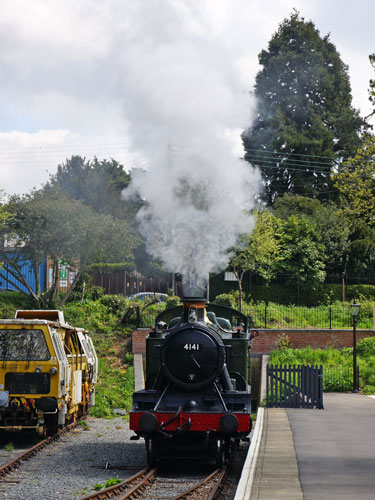

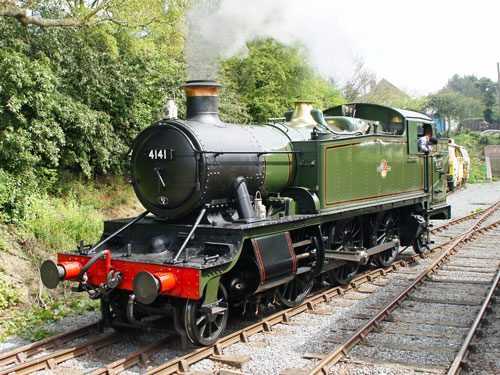
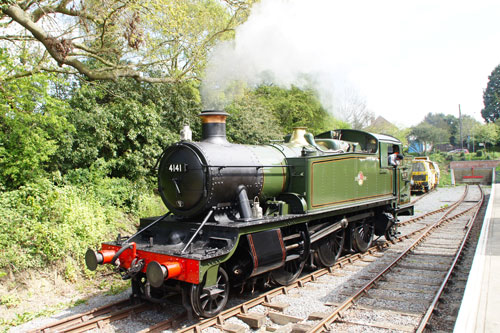
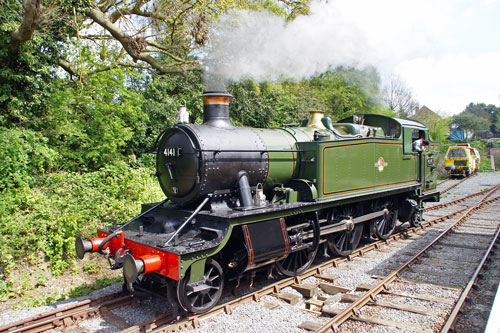
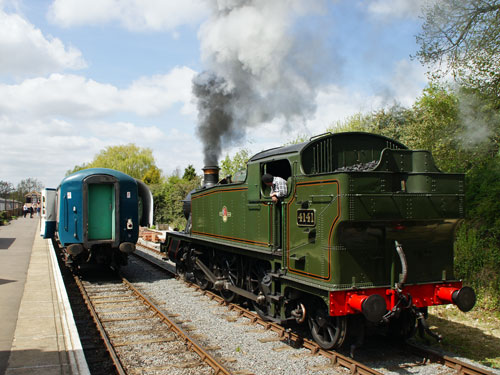
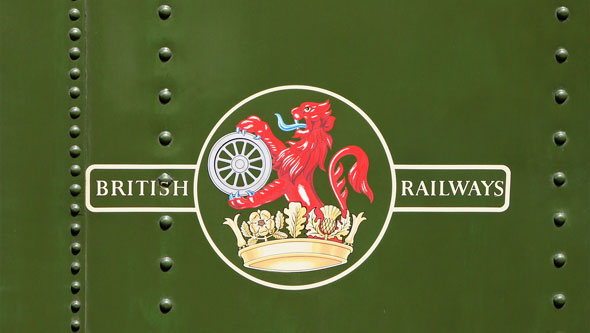
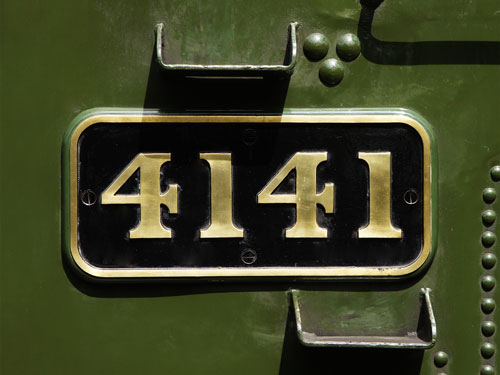
Hawthorne Leslie built saddle tank 0-6-0 locomotive
Isabel was the new Epping-Ongar owner's first steam locomotive
purchase. Built in 1919 to an order (number 3437) from ICI foodstuffs she
was delivered new to their Blackley (Manchester) dye plant that year.
Isabel was to spend the whole of her working life at the plant and
withdrawal from service finally came in 1969.
During her time with ICI she had a fairly uneventful career, the only known
incident occurred during the General Strike of 1926. Whilst being driven by
a team of enthusiastic amateurs she ran away, demolished the locomotive shed
doors and wrote off her sister engine which was standing in the shed. It is
rumoured that this is where she gained the flat spot on her wheels which she
still carries. After withdrawal Isabel went straight in to
preservation at the fledgling Somerset and Dorset Trust Site at the former
Radstock Station site.
However restoration to working order was to wait a few more years. When the
Radstock site closed and the Trust relocated to Washford on the West
Somerset Railway in 1975, Isabel followed and she was to wait until
1998 for restoration to working order to be commenced. Not wanting to rush
the process it wasn't until October 2005 for Isabel to be revealed
to the world in all her restored glory. Used for shunting the S&D Trust yard
she certainly turned a few heads.
Shortly after this in 2007 the locomotive changed hands and travelled north
to the Cambrian Railways site at Llynncs Junction. Little used she was soon
made available for sale again and in early 2010 Isabel became the
new Epping-Ongar owner's first steam locomotive. Isabel has now
reached the end of her 10-year boiler ticket, and will be given an overhaul
prior to returning into traffic.
Ref: www.llangollen-railway.org.uk/sloco6430.html
Hawthorne Leslie 1919-built
saddle tank 0-6-0 locomotive Isabel
Photo: © Ian Boyle, 25th May 2012

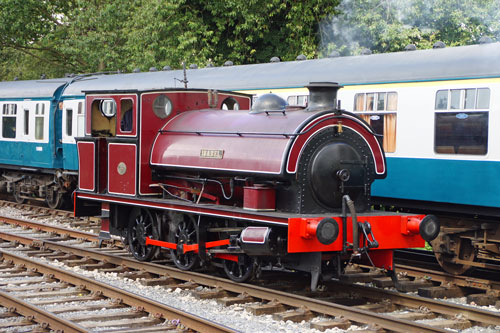
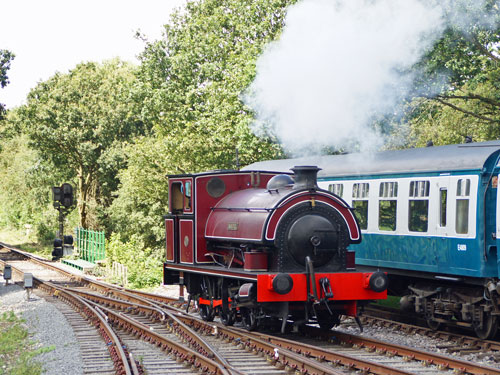
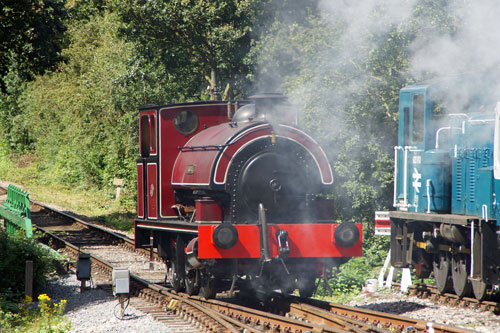
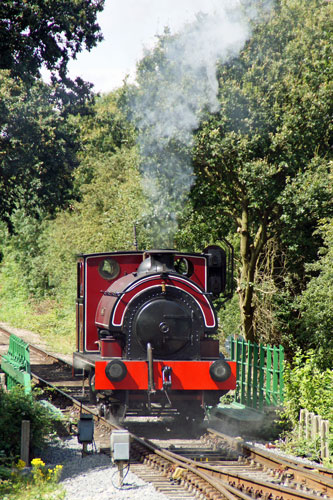
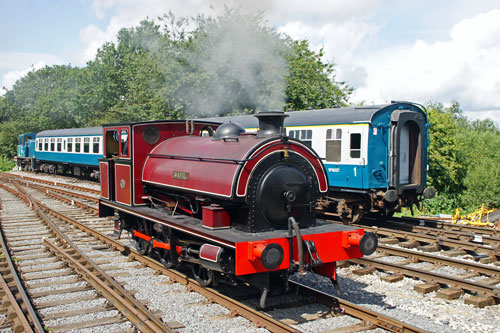

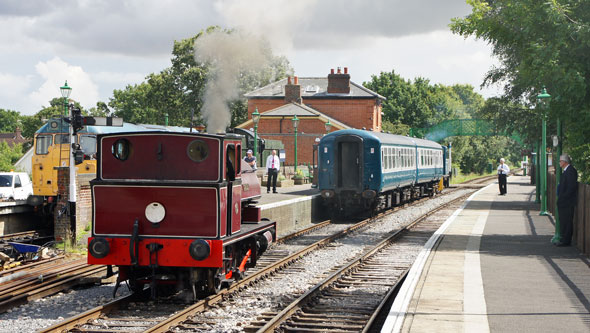
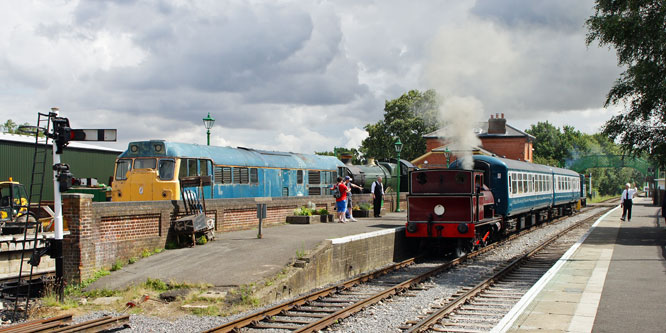
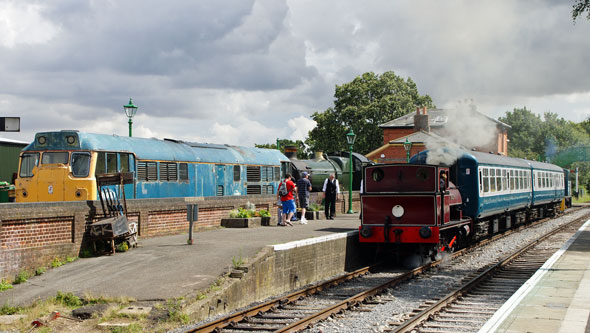
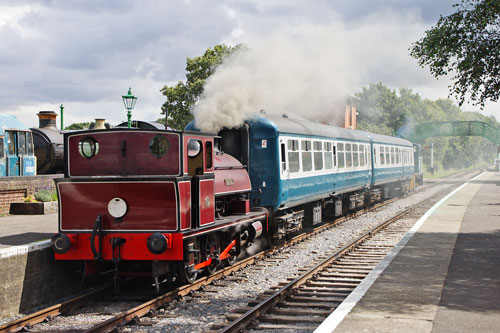
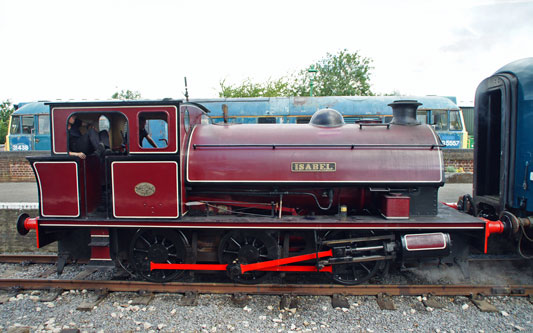
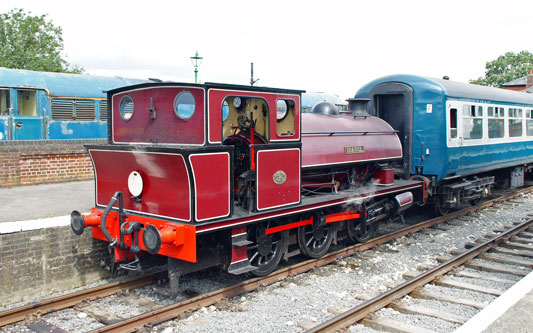
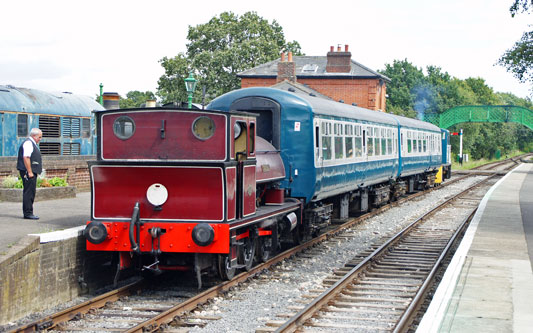
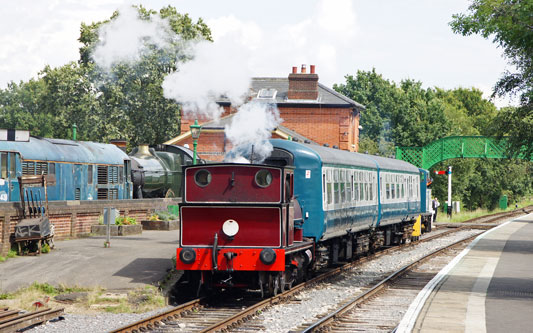
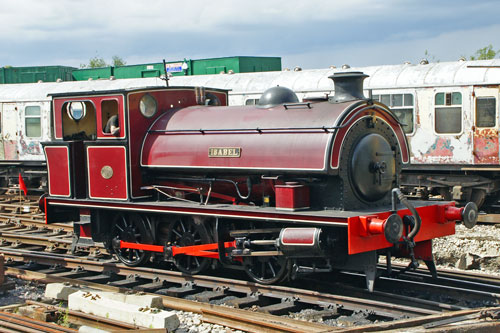
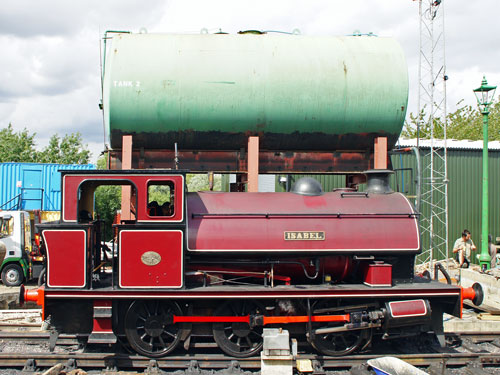
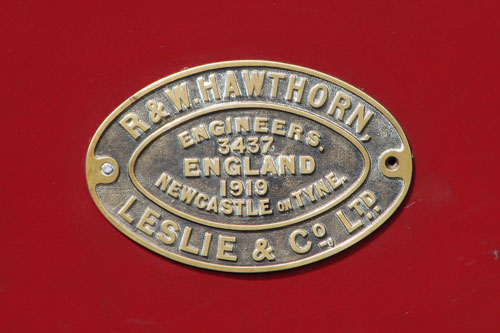
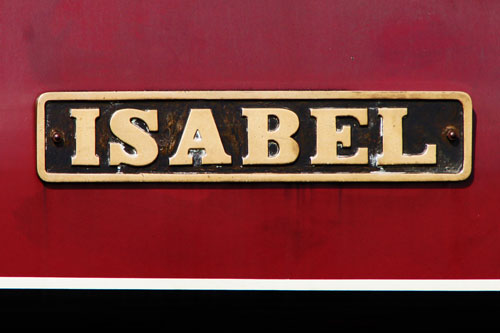
GWR 6430 - 0-6-0PT
(Visiting loco 2012)
The services of visiting loco 6430 were secured
because 4141 was unavailable for the opening weekend.
6430 is a push-pull fitted 0-6-0 pannier tank of GWR origin, built at
Swindon in 1937 as part of lot no.305. The class spent their lives working
many of the minor branch lines on the former GWR system, particularly the
South Wales valleys, and were fitted for auto train working.
Withdrawal in 1964 was followed by sale to John Cashmore Ltd as scrap, but
immediately 6430 was re-sold to the Dart Valley Railway as a source of
spares. It was towed to there by 6412 in 1966. When the remains of the
engine were purchased by its current owner in 1990, it represented an
incomplete kit of parts. It spent some time undergoing restoration at Long
Marston MOD depot, along with 5199, before moving on to the Llangollen
Railway in 1996.
Having lost many parts to other engines, restoration work was slow. Repairs
to its cracked cylinder block were tackled by the Severn Valley Railway
during 1996, and new pannier tanks were fabricated and fitted at Llangollen.
After manufacture of new axleboxes, re-wheeling took place on 24th April
1998, and work progressed slowly towards its return to steam. New motion
parts, coupling and connecting rods were cast and machined to size, whilst
other parts were found elsewhere and purchased. A major problem was the
badly corroded state of the boiler. This necessitated a completely new
boiler barrel being made and fitted to the existing smokebox and firebox.
Its first move under its own steam came on 20th December 2003. Work to
finish off the locomotive continued, and it undertook a successful trial run
along the full length of the Railway on 23rd February 2004. It was brought
by road to the Epping Ongar Railway in the week prior to opening.
Ref: www.llangollen-railway.org.uk/sloco6430.html
Visiting GWR pannier tank 6430 arriving
at Ongar
Photo: © Ian Boyle, 25th May 2012
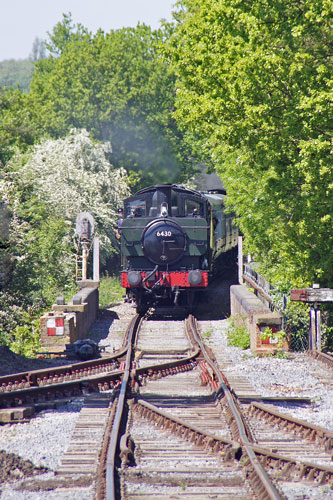
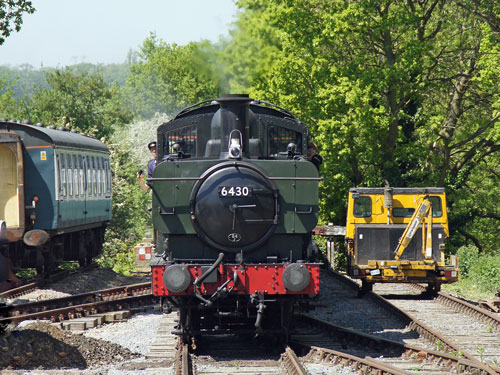
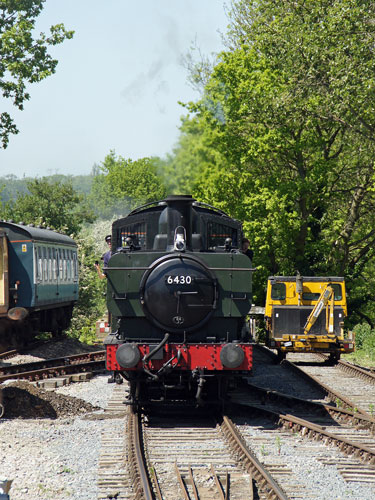
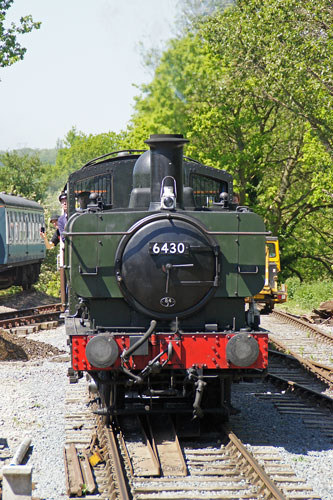
Visiting GWR pannier tank 6430 arriving
at North Weald
Photo: © Ian Boyle, 25th May 2012
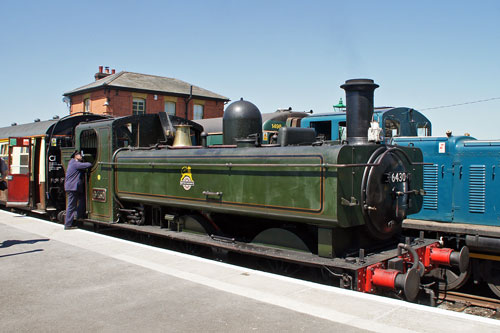
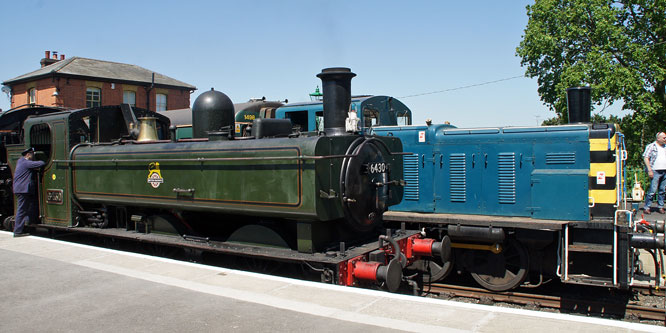
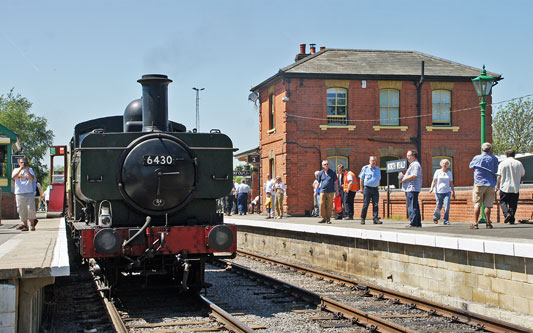
Visiting GWR pannier tank 6430 at Ongar
Photo: © Ian Boyle, 25th May 2012
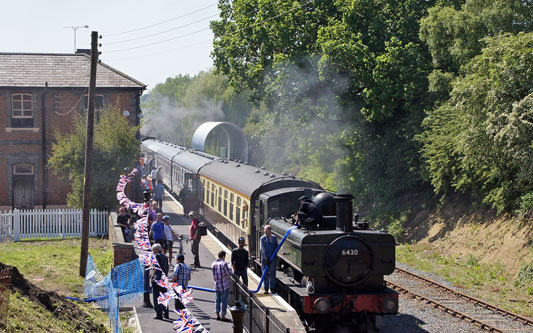
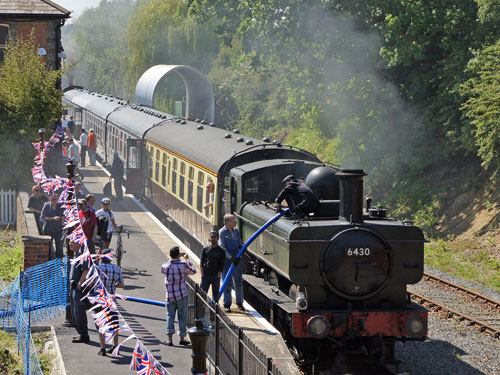
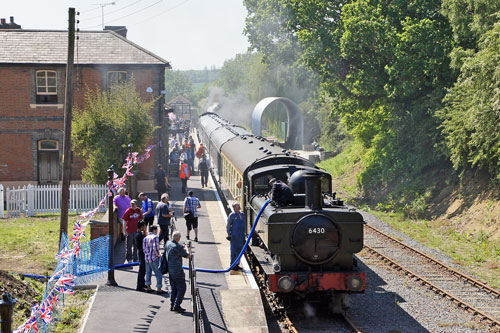
Visiting GWR pannier tank 6430
at North Wield with 03 170
Photo: © Ian Boyle, 25th May 2012
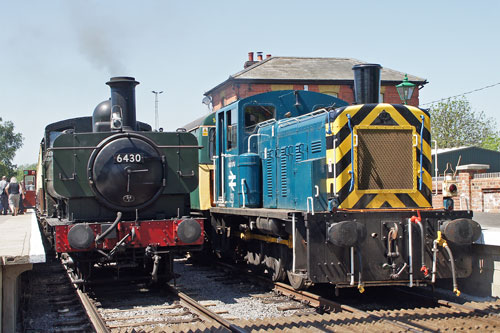

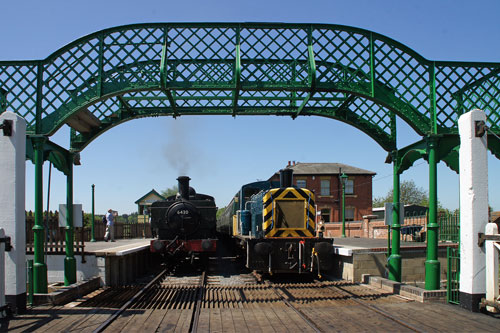
GNR N2 - 1744 - 0-6-2T
(Visiting loco 2013)
Great Northern Railway N2 Class 0-6-2T No.1744 was
built at the North British Locomotive Works, Glasgow in 1920. Withdrawn
1962. Arrived at the Great Central Railway in 1975. First returned to
traffic in 1978. Withdrawn in 1994. Returned to traffic for second time in
2009.
GNR 1744 visited the Epping-Ongar Railway for their
London Underground 150 Gala 28th June-1st July 2013.
Visiting GNR N2 running light
engine from North Weald to Ongar for the first train of the day
Photo: © Ian Boyle, 1st July 2013
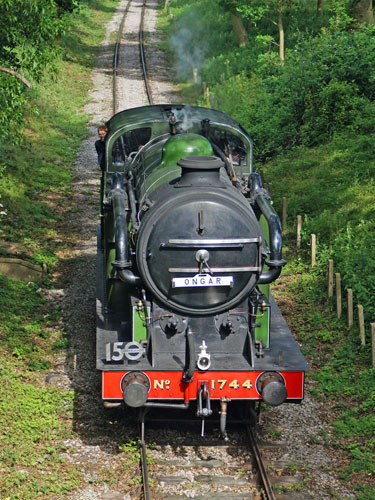
Visiting GNR N2 on the first
train of the day from Ongar to North Weald
Photo: © Ian Boyle, 1st July 2013

Visiting GNR N2 passing through
Blake Hall Station
Photo: © Ian Boyle, 1st July 2013
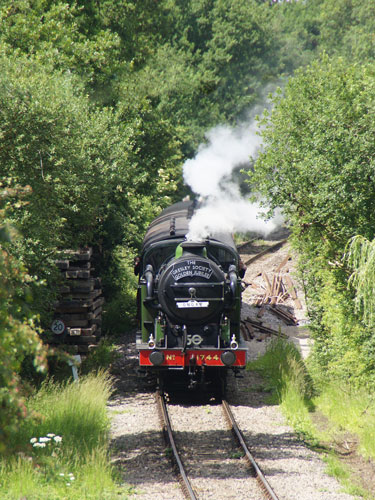
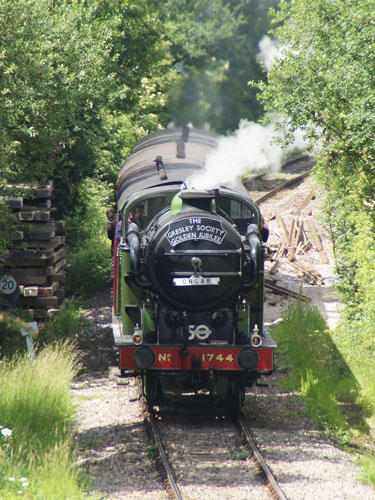
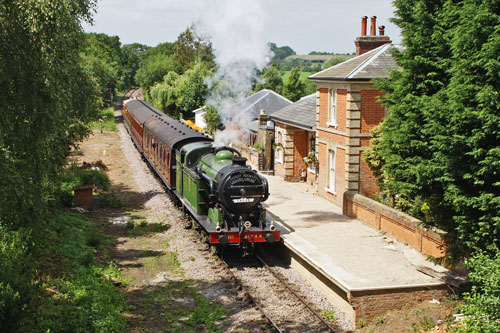
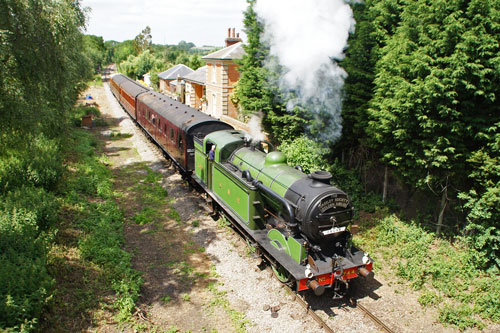
Visiting GNR N2 at North Weald
Photo: © Ian Boyle, 1st July 2013
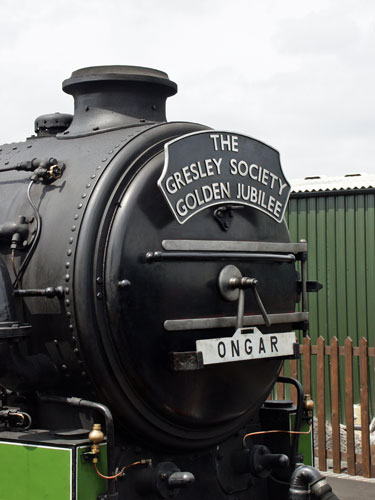
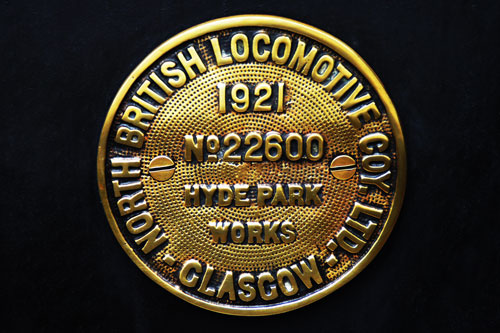
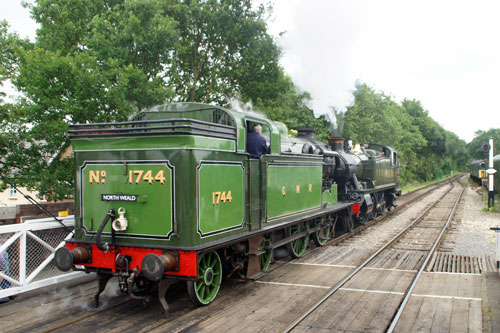
Visiting GNR N2 at Ongar
Photo: © Ian Boyle, 1st July 2013

L150 - GWR 5521 - 2-6-2T
(Visiting loco 2013)
Number 5521 was built at Swindon in 1927 and spent
most of its working life on branch lines in the West Country. After
withdrawal, having run just over a million miles, it spent time at Barry and
Bishops Lydeard before Richard and William Parker bought it in 1980. It
moved first to the Dean Forest Railway, then to the industrial estate in
Lydney, then to Swindon Works, then to the Swindon & Cricklade Railway and
back again to the DFR before it was finally restored at The Flour Mill in
the Forest of Dean from 2004 to 2007. The locomotive is generally as built,
with the addition of a Westinghouse air pump on the driver's side, so that
it has, along with the loco hand and steam brakes, the ability to brake
trains fitted with either vacuum or air brake systems.
In April 2007 5521 went by sea from Hull to Gdynia in Poland via Helsinki
and featured in the Wolsztyn Parade. It then travelled with Hungarian (ex
Sudbahn) 4-6-0 109.109 to Budapest, Hungary where it worked intermittently
with MAV Nosztalgia, the heritage rail operator. In September 2007 it
piloted the Venice Simplon-Orient-Express from Budapest Keleti to Kelenfold
stations on its return from Istanbul to Venice before competing in the
Zvolen Grand Prix in Slovakia and the Central European Steam Locomotive
Grand Prix at the Railway Heritage Park in Budapest. It returned to Poland
and in May 2008 again appeared in the Wolsztyn Parade before operating
suburban services from Wroclaw to Jelcz Laskowice, to the timings of the
electric multiple units it was replacing, for several periods of up to nine
days at a time, each with 36 scheduled stops and starts.
In 2009 5521 returned to England the way it had come, after appearing at the
Wolsztyn Parade for the third time. Since then it has visited the National
Railway Museum, the North Norfolk Railway, the Dean Forest Railway, the Spa
Valley Railway and the Bodmin and Wenford Railway. After Railfest 2012 it
returned briefly to the Dean Forest Railway for a gala at the end of June
2012, before spending August 2012 at the Swindon & Cricklade Railway, with
brief spells on the Avon Valley Railway and the Battlefield line.
In May 2013 at the request of London Underground the locomotive was painted
in red London Transport livery and numbered L.150, to commemorate the 150th
anniversary of the Metropolitan line, and on 25-27 May it operated special
trains between Harrow-on-the-Hill and Amersham, along with Met 1, 9466 and
Sarah Siddons, and it is planned to operate a similar service in early
September. After a short visit to Felixstowe Dock L.150 moved to the Epping
Ongar Railway for two weekends in June and July commemorating the
Metropolitan Railway's anniversary.
Visiting GWR Prairie 5521 as
L150 passing Blake Hall Station
Photo: © Ian Boyle, 1st July 2013
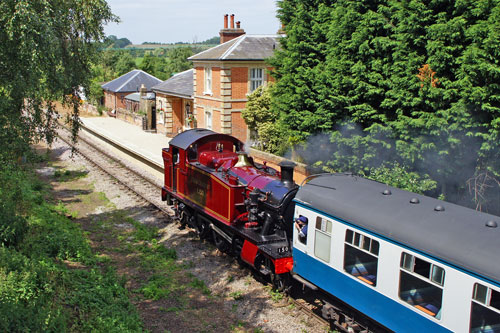
Visiting GWR Prairie 5521 as
L150 leaving North Weald
Photo: © Ian Boyle, 1st July 2013
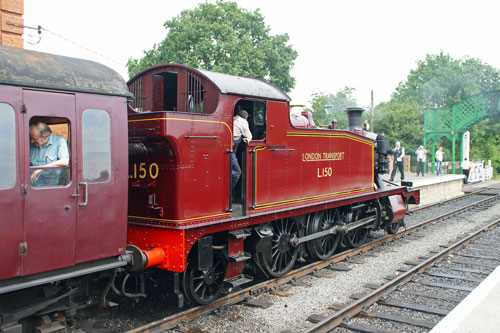
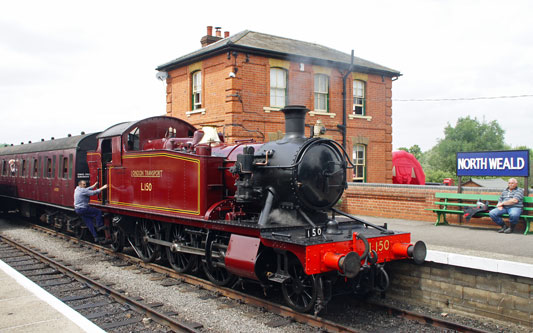
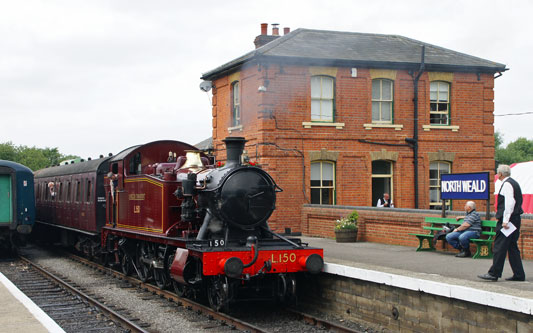
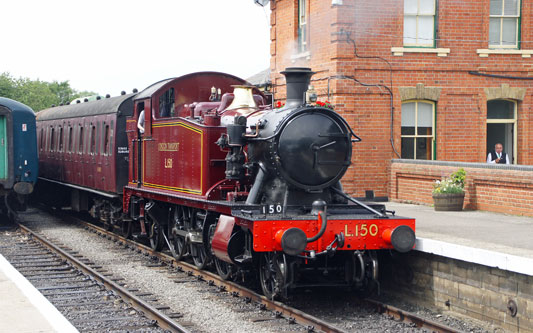
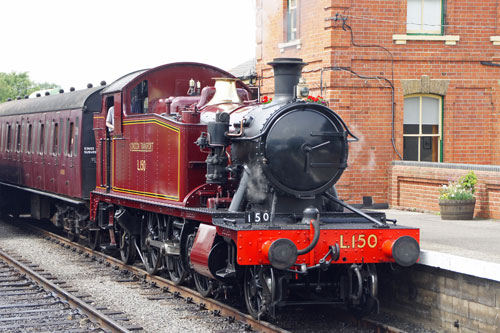
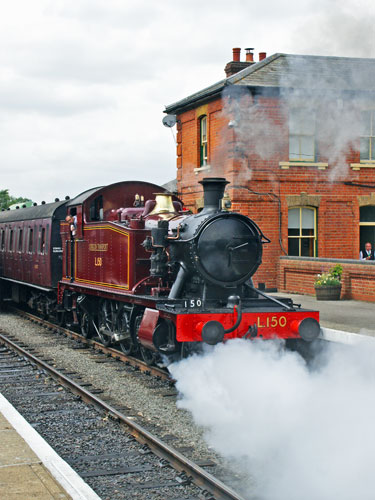

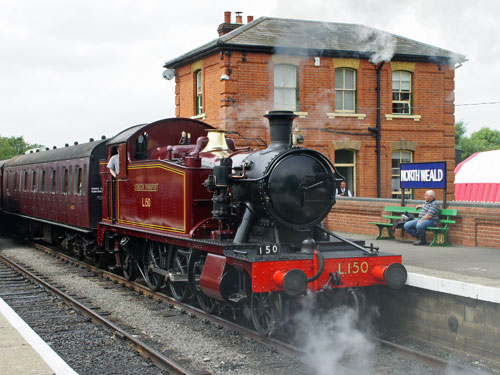
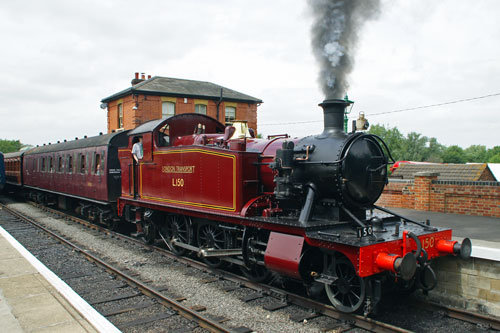
Visiting GWR Prairie 5521 as
L150
Passing through North Weald backwards on a through Ongar-Coopersale train
hauler by 0-4-4T No.1
Photo: © Ian Boyle, 1st July 2013
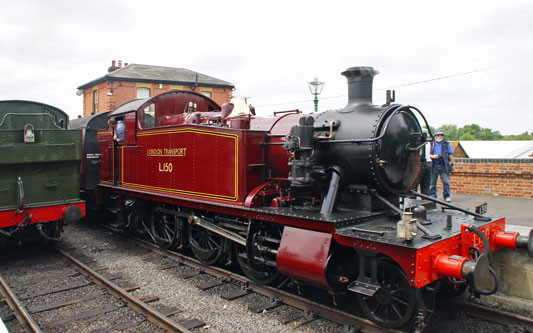
Class 37 number D6729/37 029 is resident on Epping
Ongar. Following its recent withdrawal from mainline freight workings, it
has been restored and repainted into the original 1950-1960s livery it
carried when it was based at nearby Stratford shed (30A). The locomotive is
popular with many as it has its original bodywork, complete with split
headcode nose, and is one of only a few in the whole country.
Ref:-
Epping Ongar Railway Website: eorailway.co.uk
D6729 at North Weald
Photo: © Ian Boyle, 25th May 2012
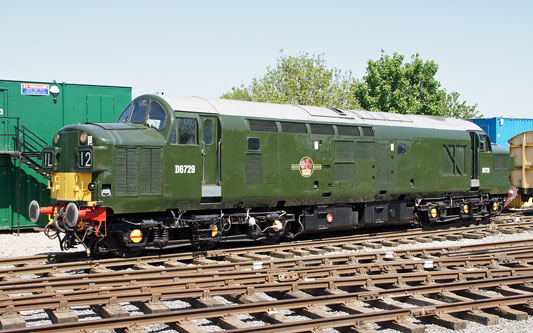
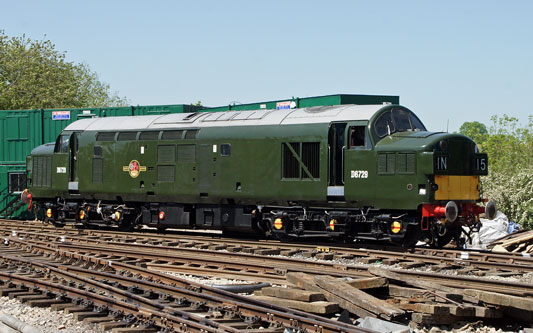

D6729 at Ongar
Photo: © Ian Boyle, 6th August 2012
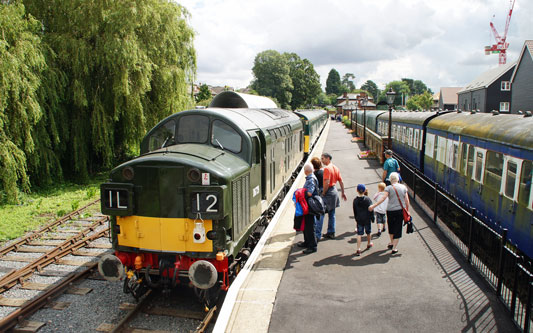
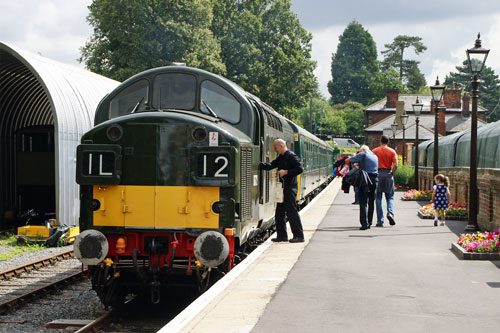
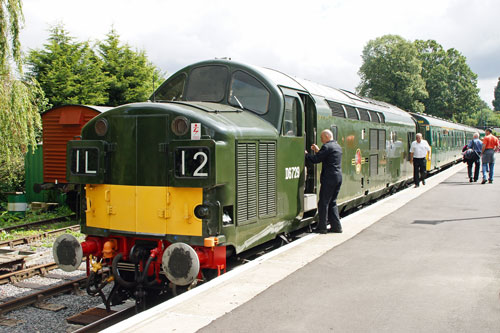
D6729 at North Weald
Photo: © Ian Boyle, 6th August 2012
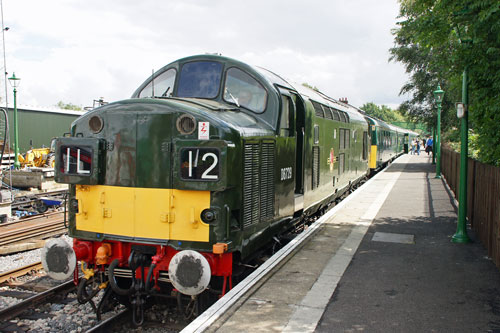
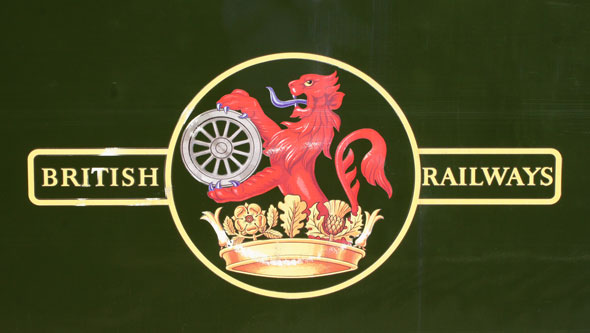
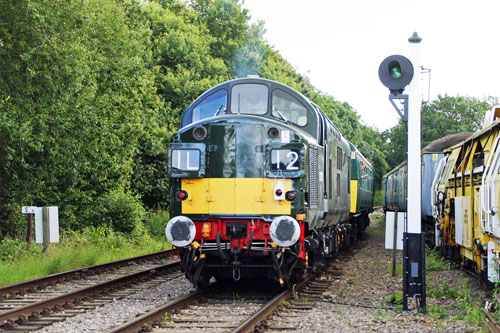
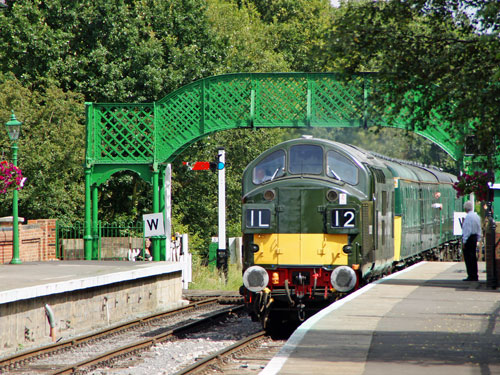
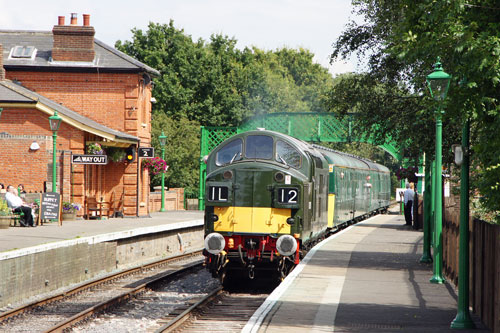
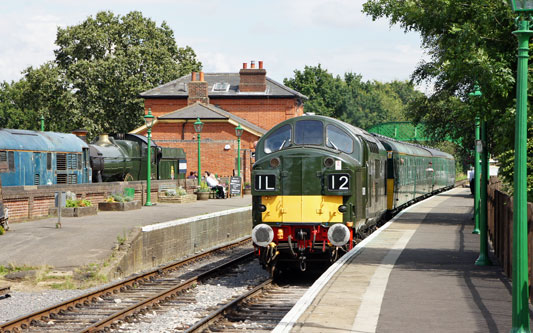
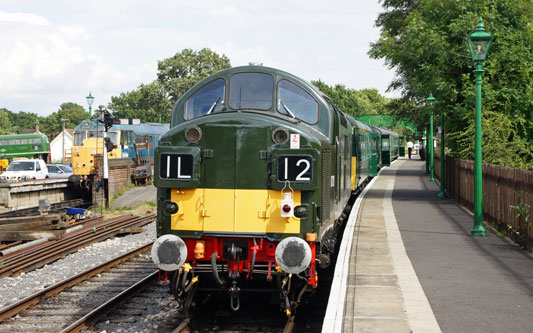
D6729 at Ongar
Photo: © Ian Boyle, 6th August 2012
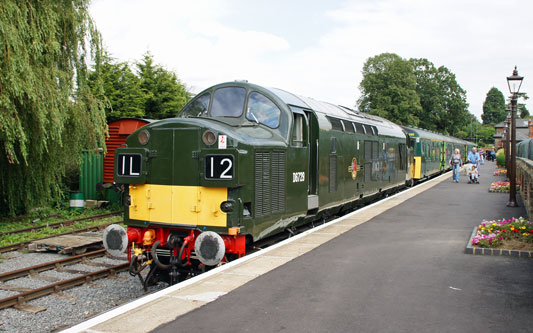

Class 31 number 31438 arrived on the Mid-Norfolk
Railway on 24 November 2001, being delivered by road from Carlisle. The
locomotive is one of a number of engines fitted with Electric Train Heating.
It was delivered new to Ipswich shed as D5557, being transferred to Norwich
between 1961 and 1965. The locomotive previously carried a unique livery of
Brunswick Green with BR arrow symbols on all four cabsides and the numbers
behind the doors. D5557 was listed as being for sale in late August 2011,
and sold to the Epping Ongar Railway by September, leaving the MNR after
their Autumn Gala.
Ref:-
Epping Ongar Railway Website: eorailway.co.uk
D5557 at North Weald
Photo: © Ian Boyle, 25th May 2012
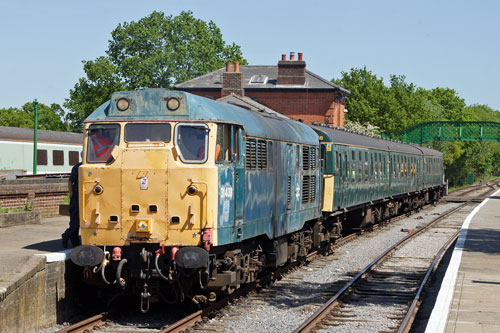
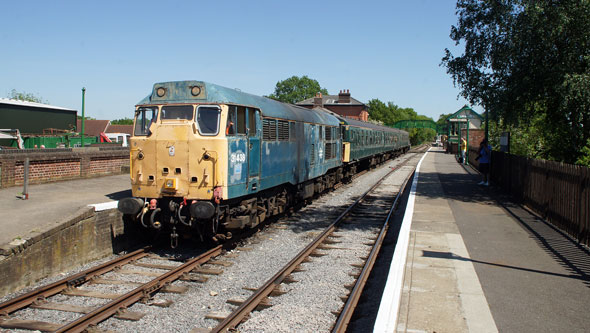
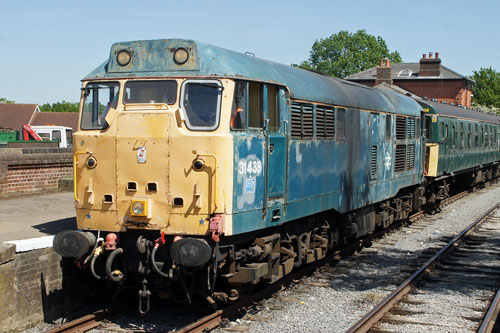
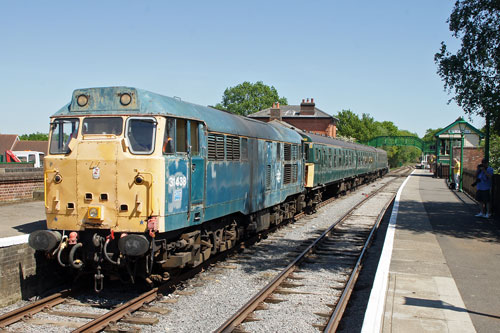
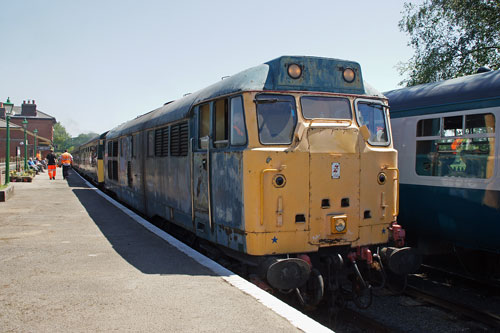
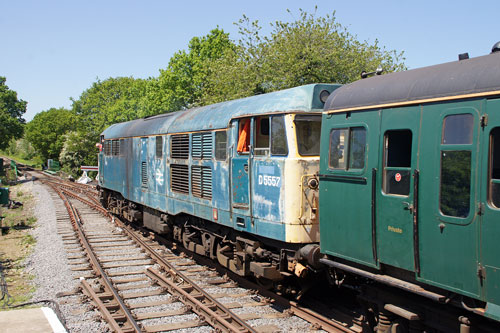
Class 25 1,250 hp Sulzer 6-cylindered engine D7523 is
resident on Epping Ongar.
The BR Class 25 originally numbered 327 examples built, of which 20 examples
were saved and about 11 are in operation on heritage lines around the
country. Our engine is a 25/2, which featured restyled bodywork (without the
earlier gangway doors in the front) and slightly different air intakes from
the first batch built. While the Southern and Eastern Regions of BR were
never allocated this class, they were often seen in East Anglia on
inter-region passenger and freight workings and excursion work.
The construction of D7523 started with the main support frames being laid
during early 1964, delivery to the Nottingham area occurring in January
1965. The locomotive remained a Midland Region based machine throughout its
career which ended with withdrawal on 19 March 1987, being one of the last
locomotives of the class in service. The engine was fitted with air brakes
(making it dual braked) during a routine overhaul in 1978.
D7523 was officially withdrawn at midday on 19/03/1987 at Crewe, on 23/03/87
it was sent along with several other locomotives to Vic Berry's scrap yard
in Leicester. Normally the processing of scrap loco's and dumping them on
the 'pile' only took a few days but for some reason D7523 (or 25173 as she
was) lingered and on 13/09/87 left the yard again and returned to Crewe
works for repairs. This was unexpected as all of the class had been
officially withdrawn in March 1987. Over the following two years the loco
alternated between Crewe works and Berry's yard, each time it visited Crewe
it received further repairs. Finally on 01/06/1989 the locomotive that
refused to be scrapped left Crewe and headed for the Dean Forest Railway and
into preservation. D7523 spent 15 years in service at the West Somerset
Railway, proving to be a useful engine for both light passenger and
engineering trains, being maintained to a very high standard by the Diesel
Electric Preservation Group at Wiliton, before coming to Epping Ongar
Railway in September 2011.
Ref:-
Epping Ongar Railway Website: eorailway.co.uk
D7523 at Ongar
Photo: © Ian Boyle, 5th May 2013
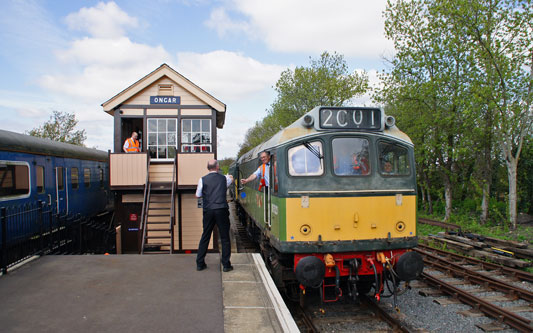
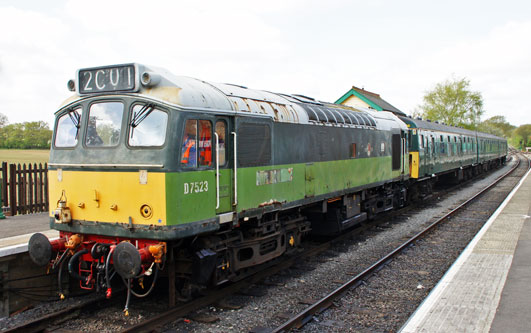
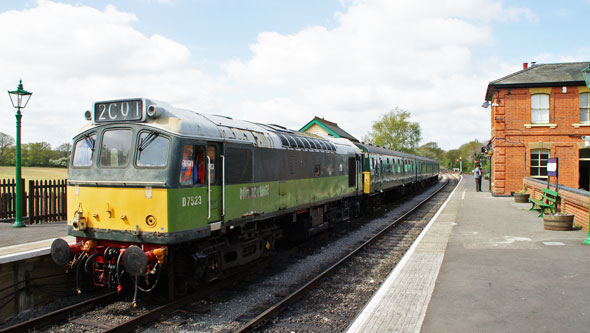

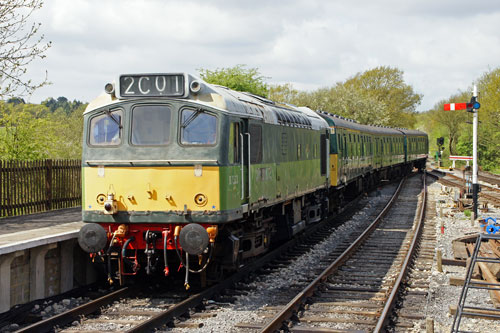
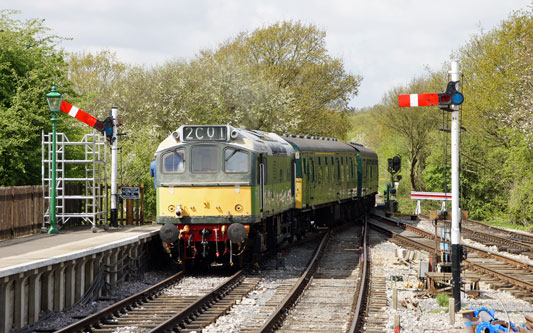
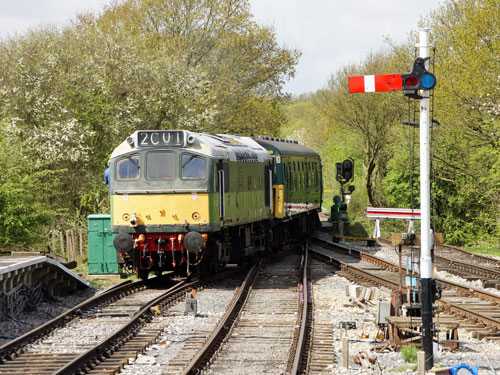

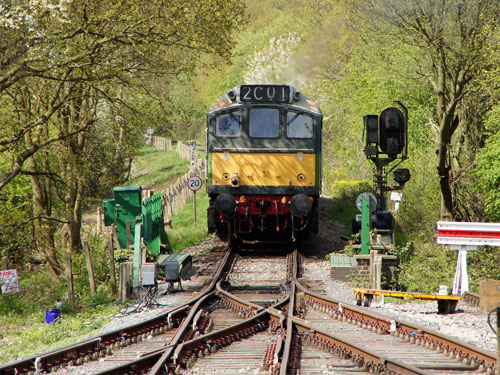
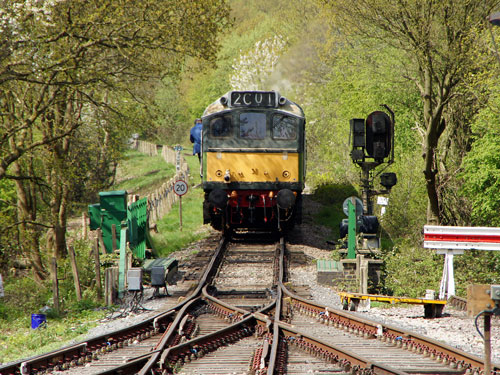
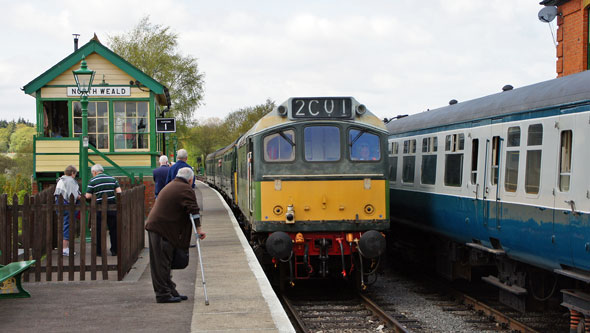
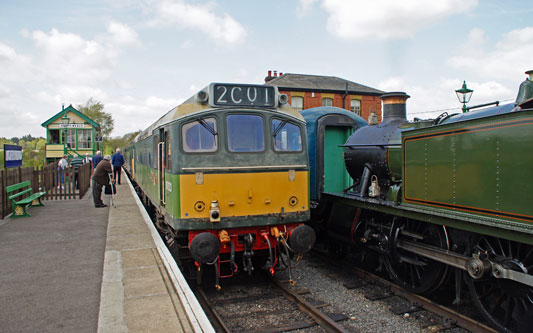
03119 is a unique engine as it was one of the
specially modified Class 03 shunters which was modified to have a "cut
down", reduced height cab to enable it to work the Burry Port & Gwendraeth
Valley branch which had lower bridges, and fitted with air operated controls
so they could be worked in pairs to cope with the heavy loads. Built at BR
Swindon Works and introduced in September 1959 as D2119, it was allocated
initially to Danygraig depot.
Renumbered to 03119 in March 1974, it was withdrawn from traffic while
allocated to Landore Depot in February 1986. After arriving at Knills scrap
yard, Barry, in November 1986, 03119 was quickly saved and moved to the Dean
Forest Railway by December 1986 to enter railway preservation. 03119 made
the move to the West Somerset Railway in March 1996, where it has been kept
in good working order by the Diesel and Electric Preservation Group at
Williton before coming to EOR in Dec 2011. The locomotive carries the BR
livery, and 03 shunters were once a common sight all over the country,
including at many East Anglian stations on shunting duties.
Ref:-
Epping Ongar Railway Website: eorailway.co.uk
03 119 at North Weald
There was no loop at Coopersale so trains either have a loco at each end or
use the 3CIG
Photo: © Ian Boyle, 25th May 2012
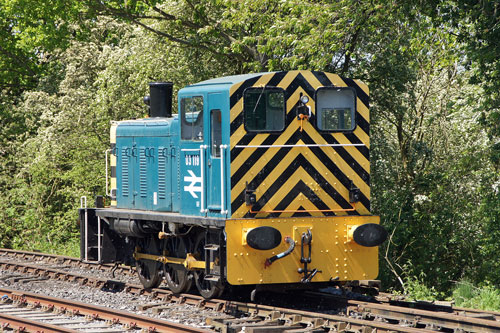
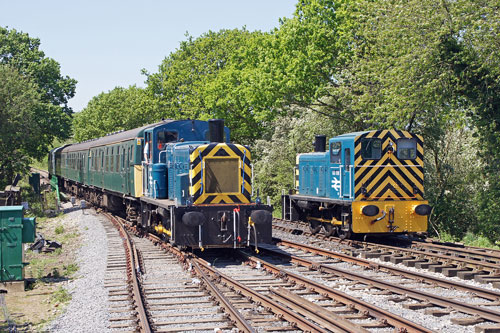
03 119 arriving at North Weald
from Coopersale
Photo: © Ian Boyle, 6th August 2012
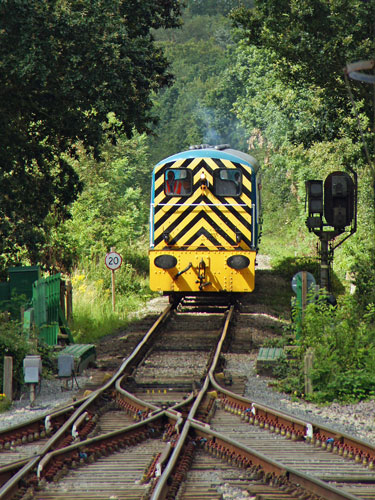

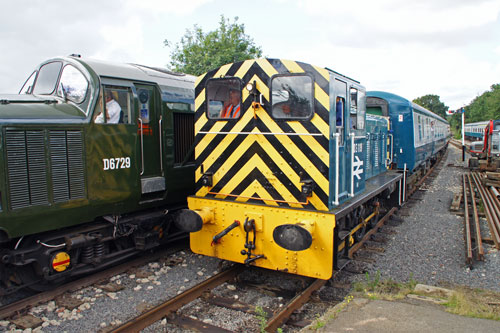
03 119 at North Weald
Photo: © Ian Boyle, 6th August 2012
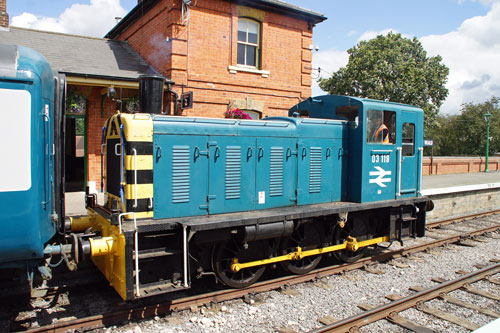
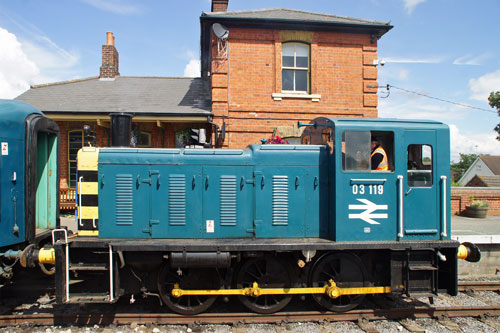
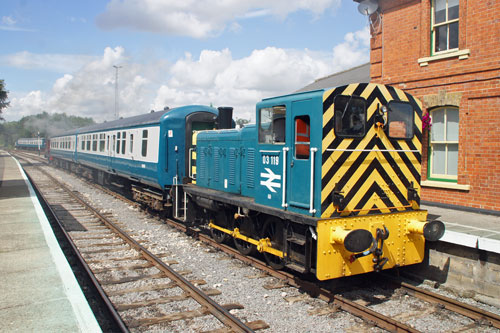
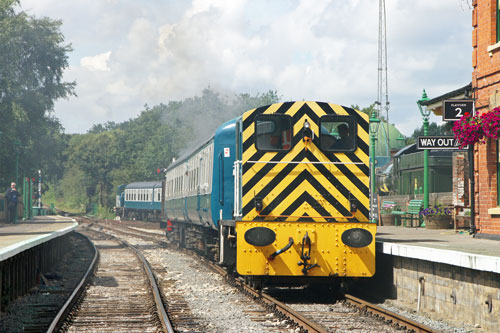
03 119 leaving North Weald for
Coopersale, towed by Isabel
Photo: © Ian Boyle, 6th August 2012

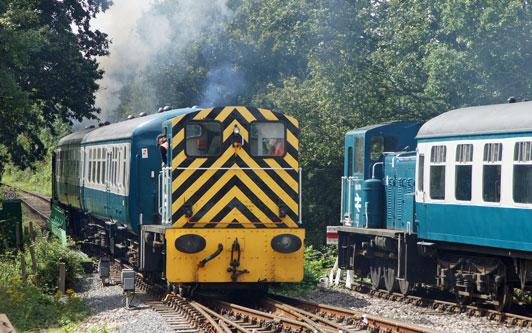
03 119 arriving at North Weald,
towing Isabel at the far end of the train
Photo: © Ian Boyle, 6th August 2012
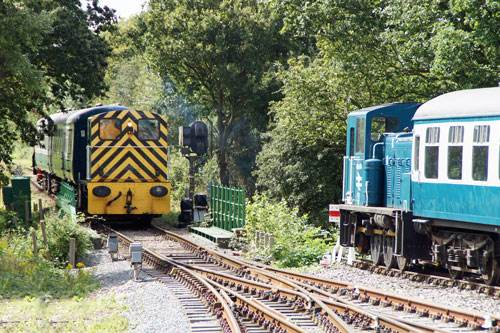
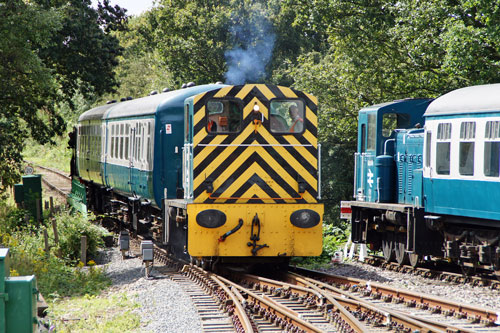

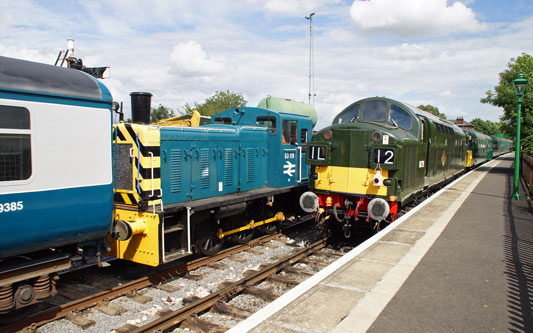
Class 03 shunter; 204 BHP Drewery diesel mechanical
shunter. Delivered new to British Railways as D2170 in late 1960, it was
withdrawn in 1989. This is a class of locomotive that has a long history of
working in East Anglia, members of the class being allocated to Stratford,
Colchester, Ipswich and Norwich Depots up until the late 1980s. This
locomotive has dual (air and vacuum) braking systems. Its claim to fame is
that it was the last 03 converted and overhauled at Swindon works before
they closed.
Ref:-
Epping Ongar Railway Website: eorailway.co.uk
03 170 at North Weald
Photo: © Ian Boyle, 25th May 2012




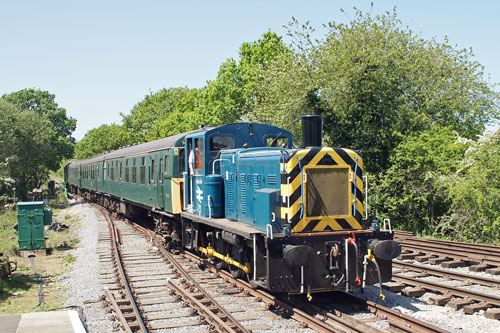



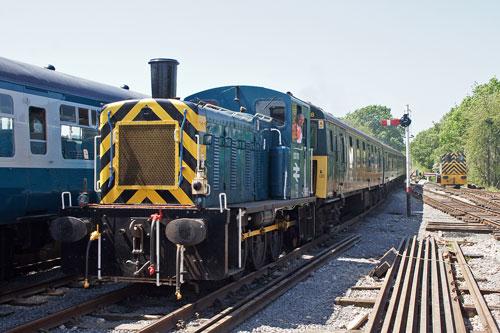
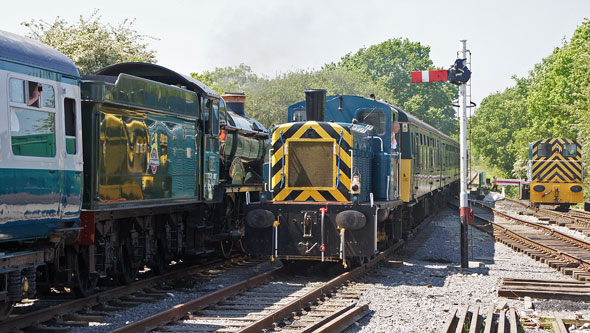
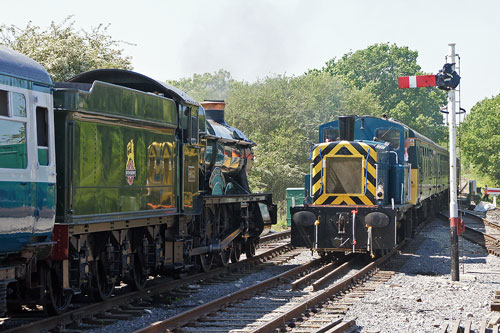
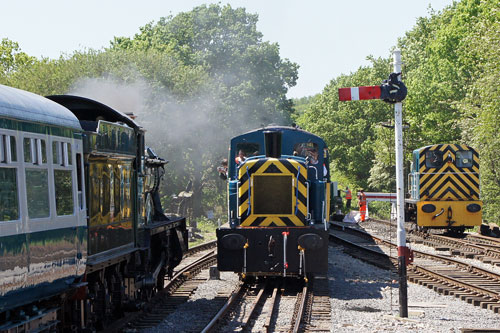
The Epping-Ongar 3CIG is one of the Phase 2 units,
which entered service in 1960s. It was previously numbered 1888, 1223, then
7423. The unit was originally a 4 coach electric unit, and entered BR
service in the corporate blue & grey livery.
The unit became famous as one of the last "slam door" EMUs in mainline
service, seeing out its final days on the Lymington Branch, gaining the
nick-name of Lymmy Slammer.
South West Trains considered that due to the self contained nature of the
Lymington branch it would be more cost effective to continue Mk 1 operation.
On this basis SWT bought and refurbished two British Rail 4CIGs / Class 421
units to exclusively operate services on the line. Work carried out on the
units included the fitting of central door locking and other safety features
to allow them to remain in service beyond the November 2005 deadline for the
withdrawal of slam-door stock and the reduction of the original 4 carriage
units to 3 carriages (3CIG) to address the extreme height difference between
the train and the platform at Lymington Town.
The 3CIG carries the BR green livery with the painting diagram devised by WS
Atkins. The unit was numbered 1498 and officially named Farringford at a
ceremony at Brockenhurst railway station on May 12, 2005. The heritage
service commenced on 12 May 2005 and an exemption was obtained to enable the
use of the 3CIG units until 2013, at which point they were estimated to be
life expired. However, in Summer 2009 South West Trains announced plans to
replace the heritage EMUs with more modern units. This change took place on
the 23 May 2010, with the final 3CIG service departing from Lymington Pier
on the 22 May 2010 at 22:14 and arriving at Brockenhurst at 22:24.
Epping Ongar Railway was delighted to have the opportunity to preserve this
unit, and will use this on the branch with a diesel locomotive. The railway
is working closely with EMU societies, both to help with its preservation,
and perhaps one day to once again see the unit push-pull with an appropriate
diesel locomotive under control from the 3CIG. It has also run as a 4-car
set with the addition of a standard green Mk1 coach.
Ref:-
Epping Ongar Railway Website: eorailway.co.uk
3-CIG at North Wield, top and
tailed by Class 31 and Class 03
Photo: © Ian Boyle, 25th May 2012
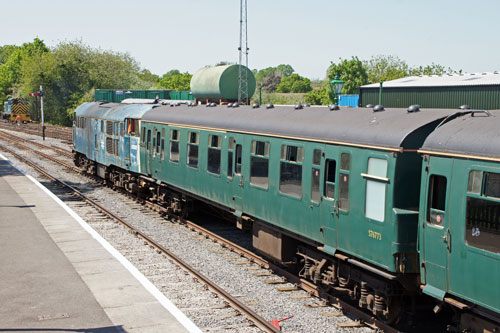
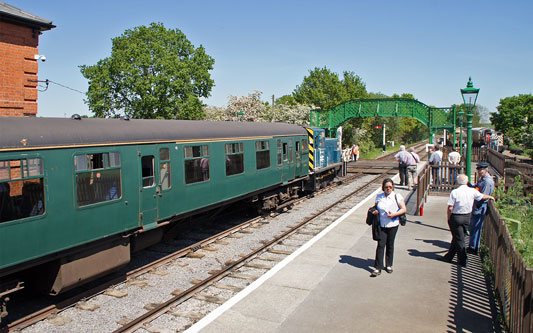
3-CIG at Ongar - powered by
Class 25
Photo: © Ian Boyle, 5th May 2013
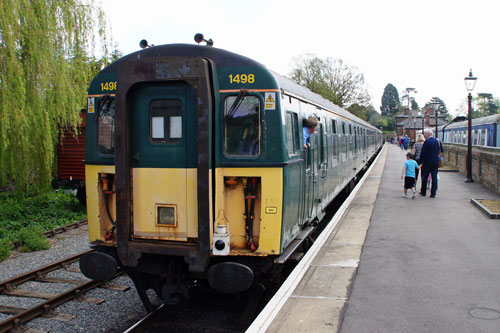
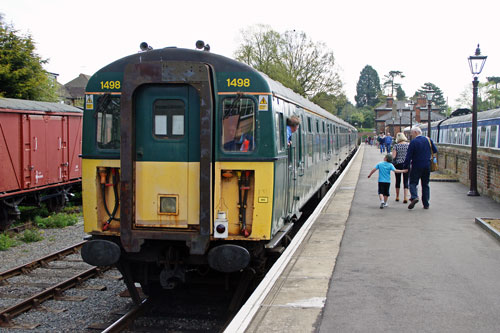
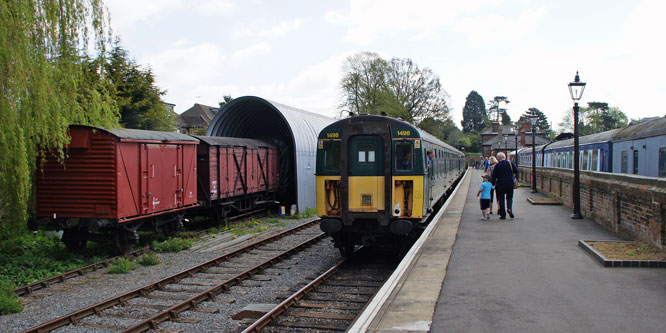
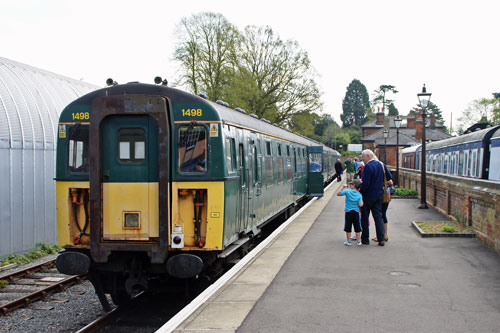
3-CIG at North Weald - powered
by Class 25
Photo: © Ian Boyle, 5th May 2013
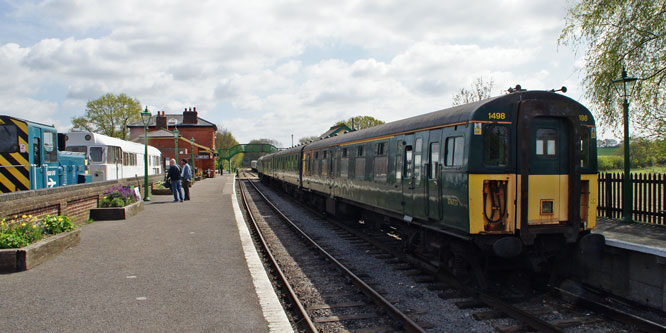
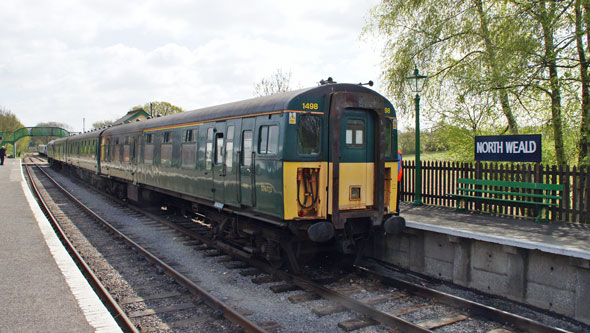
Finnish loco 1060 is a Tr1 class
heavy good train locomotive (R1 class until 1942). The Tr1 was almost
identical to the slightly older Hr1 class passenger locomotives, with most
parts being interchangeable and the wheel arrangement as the major
difference between the classes (Tr1 being a Mikado 2-8-2 type while Hr1 was
a 4-6-2 pacific). The Tr1 top speed was 80 km/h. The Tr1 class was nicknamed
"Risto" after the Finnish president Risto Ryti. A total of 67 locomotives
were built by Lokomo, Tampella and Jung between 1940 and 1957. The last
Risto, number 1096, was the last steam locomotive built for the Finnish
state railways. The locomotives were withdrawn in the 1970s, but 20 units
survive, most of them in the Haapamäki locomotive park in central Finland.
(Kalle Id)
There is an appeal fund to buy this loco and move it to the Mizens Railway
near Woking. It was still at Ongar in May 2013.
Finnish 2-8-2 steam loco 1060 at
Ongar
Photo: © Ian Boyle, 3rd April 2005
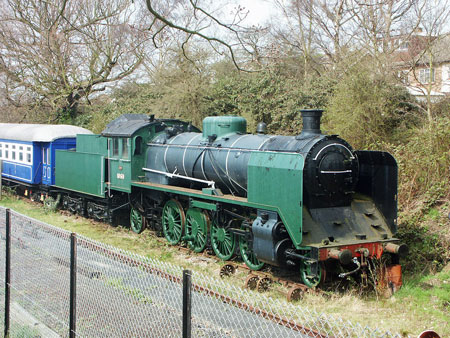

Finnish 2-8-2 steam loco 1060 at
Ongar
Photo: © Ian Boyle, 8th August 2012
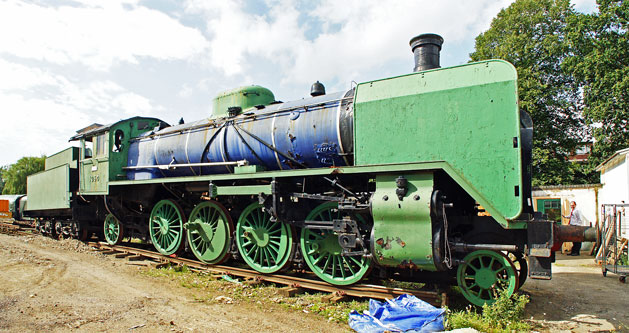
Hr1 Class Pacific -
4-6-2
Hr1 class heavy passenger locomotive
(originally P1 class, pacific wheel arrangement), number 1016. Built between
the years 1937 and 1957, this 22-unit Hr1 class was the pride of the Finnish
railways. They had a top speed of 110 km/h and were nicknamed Ukko-Pekka
(roughly "Old Man Pete") after the Finnish president Pehr Evind Svinhufvud.
The Hr1 class were withdrawn from service in 1974, when they were the
reportedly the last Pacific-type locomotives in regular use in Europe
outside of the East Block. Two units have been preserved in working order
and a further 15 in non-working order - in other words only 5 have been
scrapped. . (Kalle Id)
This loco was still on the railway in May 2013.
Finnish 4-6-2 steam loco at
Ongar
Photo: © Ian Boyle, 3rd April 2005
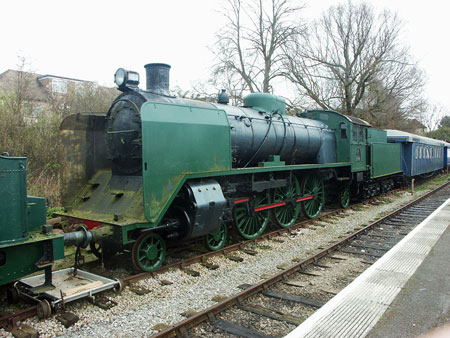
Finnish 2-8-2 steam loco 1060 at
Ongar
Photo: © Ian Boyle, 8th August 2012
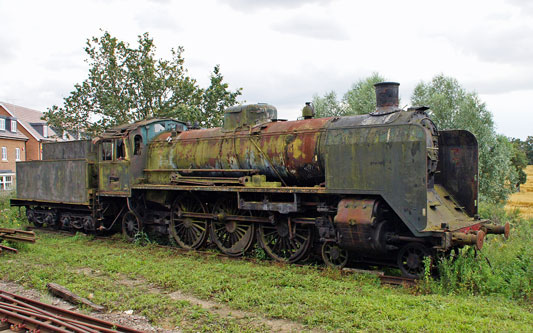
Vr1 class light goods locomotive (originally K5 class), 2-8-0 wheel
arrangement. The Vr1 was the most numerous locomotive class in Finland, with
161 units produced, first 100 between the years 1927 and 1935 (by Lokomo and
Tampella).
This loco is no longer on the railway.
Finnish 2-8-0 steam loco 1134 at
Ongar (since moved)
Photo: © Ian Boyle, 3rd April 2005
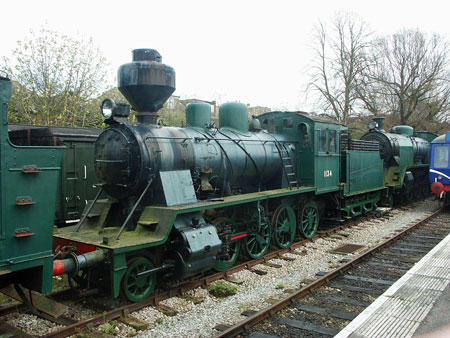
This is a Tk3-class (originally L1-class, the classification system was
overhauled in 1942) heavy shunter. The class was nicknamed "kana" (hen), top
speed 25 km/h. A total of 43 units were built between 1913 and 1927 by
Tampella and Hanomag. This locomotive dates from 1925 and was built by
Tampella. A total of 17 Tk3's survive according to Wikipedia.
This loco is no longer on the railway.
Finnish 0-6-0T steam loco 794 at
Ongar (since moved)
Photo: © Ian Boyle, 3rd April 2005
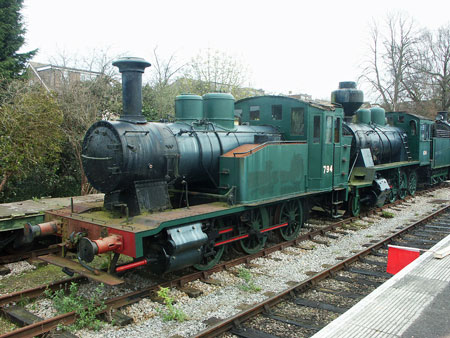
D1995
D1995 at Ongar (not in 2012
fleet list)
Photo: © Ian Boyle, 3rd April 2005
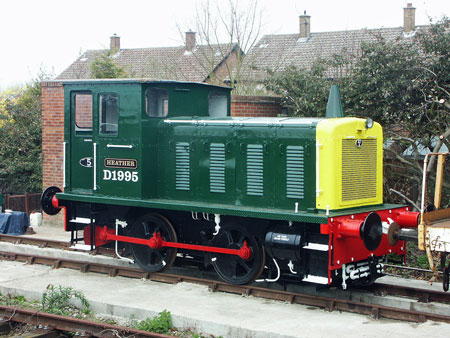
M51342
M51342 at Ongar (since repainted
BR green)
Photo: © Ian Boyle, 3rd April 2005
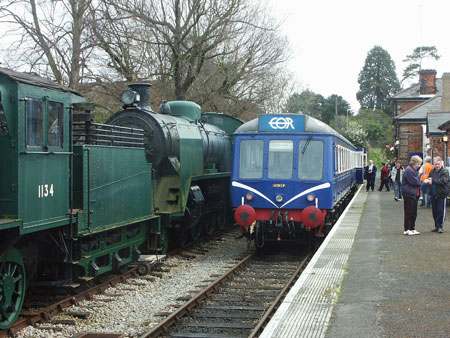
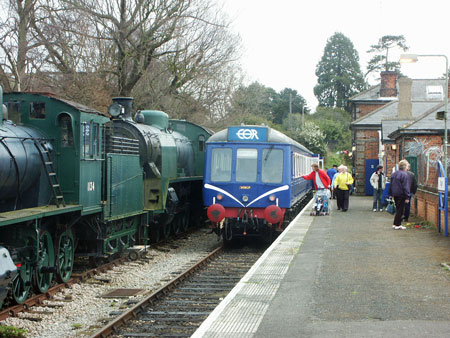
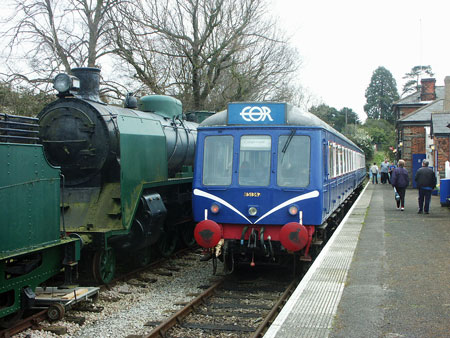

M51384
M51384 at North Weald (since
repainted BR green)
Photo: © Ian Boyle, 3rd April 2005
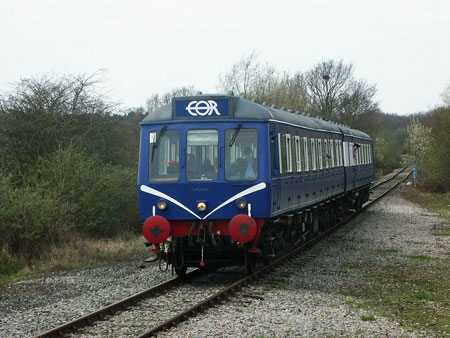
This remained the case until 1949, when the London Transport Passenger
Board's New Works scheme extended the Central Line to Epping using electric
trains (taking over the railway from British Rail). The Epping-Ongar branch
lost its through trains to London, and a shuttle service between Epping (to
connect with trains to London) and Ongar was implemented. For a short time,
one could see the unusual sight of steam trains and London Underground
electric multiple units side-by-side at Epping.
The 1950s saw attempts to improve the service on the branch, and eventually
the line was given light electrification in 1957. The low-cost nature of the
electrification meant that the branch could only support short trains - the
power supply was simply not sufficient to support full-size trains, and the
short platforms on the branch line would not have been long enough to
support eight-car trains. Hence, the Epping to Ongar branch was normally
operated as an isolated branch of the Central Line. On September 30, 1994,
passenger services on the line, which was making a loss of seven pounds for
each passenger journey and was in need of some expensive maintenance work,
were suspended, the Central Line terminating at Epping Station. At the time
the passenger services were suspended, it was carrying a mere 80 passengers
a day. The track was left intact along with the stations
Central Line Tube Stock
Central Line 4-car tube stock at
Epping and Ongar in 1986
Photo: ©1986 Ian Boyle
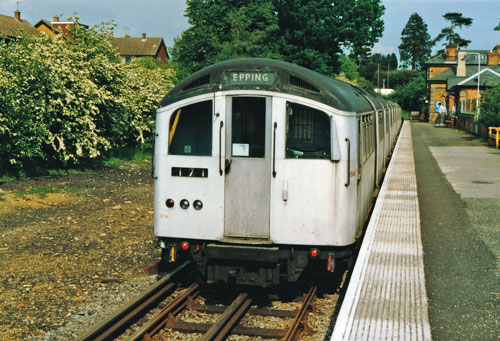
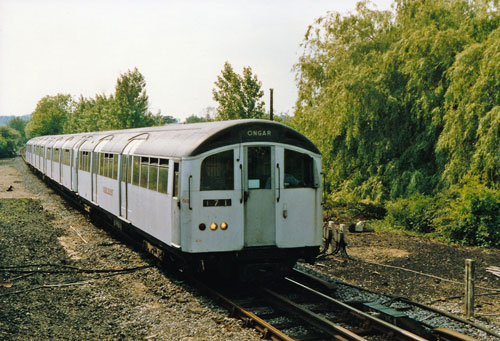
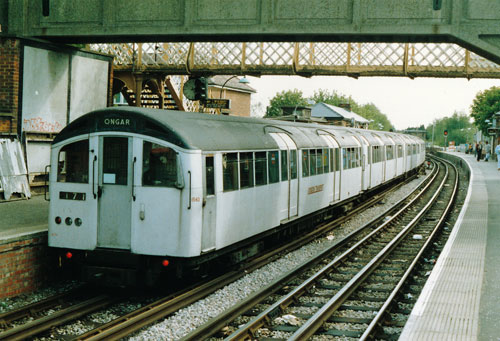
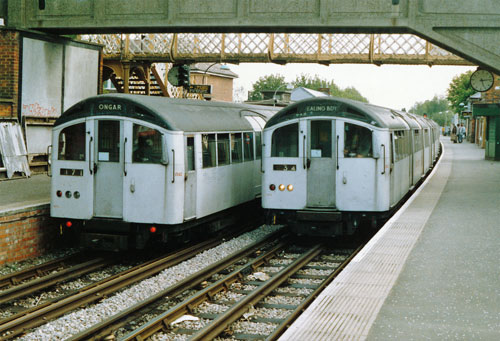
RM1641 - 641 DYE
Routemaster RM1641 at North
Wield
Photo: © Ian Boyle, 3rd April 2005
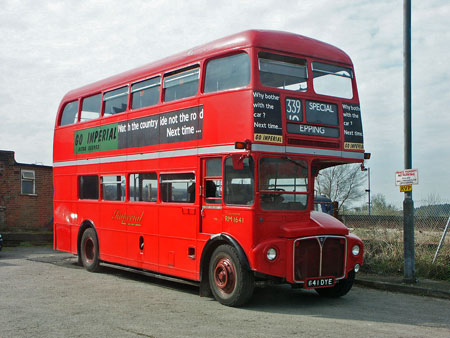
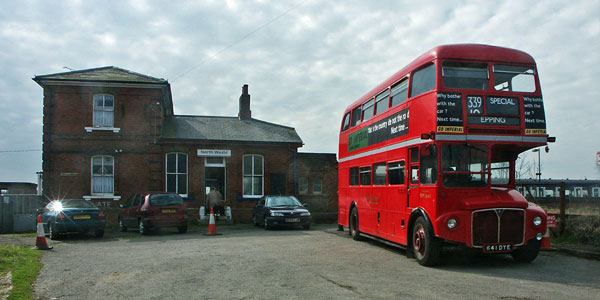
RF401 - MXX 289
RF401 at North
Wield
Photo: © Ian Boyle, 1st July 2013
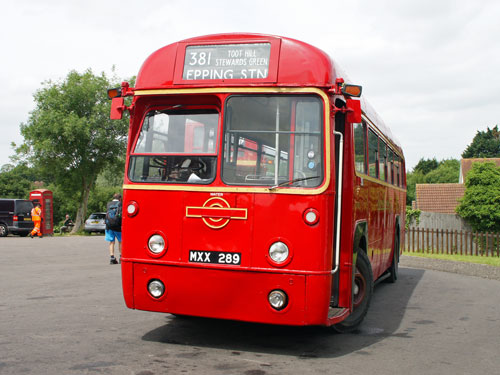
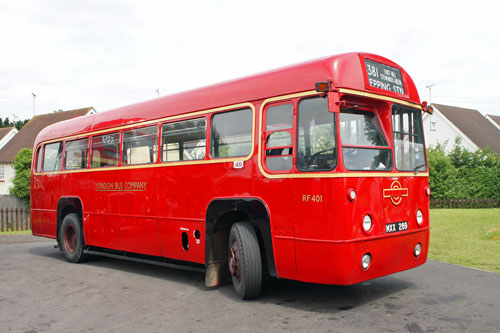
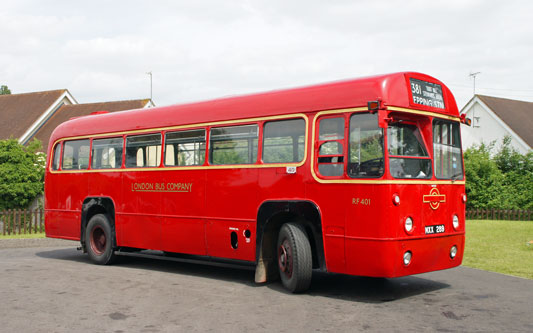
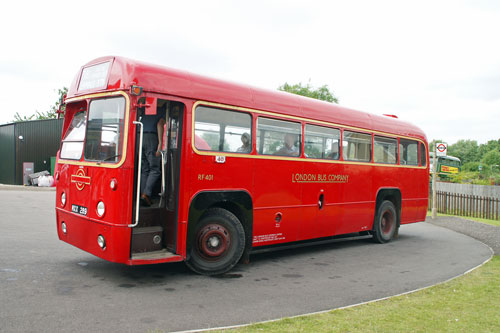

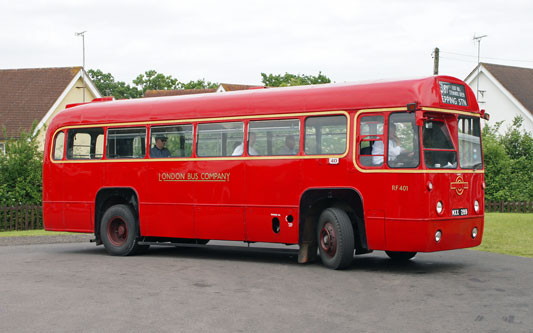
Church of St
Andrew - Greensted-juxta-Ongar
Greensted Church, in the small village of
Greensted-juxta-Ongar, near Chipping Ongar in Essex, England, is the oldest
wooden church in the world, and probably the oldest wooden building in
Europe still standing, albeit only in part, since few sections of its
original wooden structure remain. The oak walls are often classified as
remnants of a palisade church or a kind of early stave church, dated either
to the mid-9th or mid-11th century. The church is close to the Epping Ongar
Railway on the road between Ongar and Blake Hall station. A public footpath
leads from the church to a public crossing across the railway.
The church lies about a mile west of Chipping Ongar
town centre. Its full title is The Church of St Andrew,
Greensted-juxta-Ongar, renerally known just as Greensted Church. Greensted
is still a functioning church and holds services every week. The church was
featured on a British postage stamp issued in 1972.
Greensted Church has stood in its idyllic setting for nearly 1200 years.
Archaeological evidence suggests that, before there was a permanent
structure, there may well have been another church, or a holy place, on the
site for much longer, possibly dating back to around the 4th century.
Construction of the first permanent church on this site is thought to have
begun shortly after St Cedd began his conversion of the East Saxon people
around 654. The archaeological remnants of two simple wooden buildings were
discovered under the present chancel floor, and these are thought to have
been built in the late sixth or early 7th century.
The church's dedication to St Andrew suggests a Celtic foundation for the
original sanctuary. The body of King Edmund the Martyr of East Anglia (who
was killed in 870, possibly at Hoxne) is said to have rested there in 1013,
on its way to reburial at Bury St Edmunds. There are many tributes to St
Edmund in the church itself.
Near the porch, a large, flat, coped stone marks the resting place of an
unknown early crusader who is said to have arrived, badly wounded, at the
church and died there. The fact that it was made of stone, not a local
material, and was placed against the south wall, suggests he was considered
as a hero.
The Tolpuddle Martyrs were granted farm tenancies in the area after they
were unable to return to their Dorset homes and the record of marriage of
one of them, James Brine, can be seen in the present register. Ref:
Wikipedia.com
Greensted Saxon wooden church
Photo: © Ian Boyle, 1st July 2013

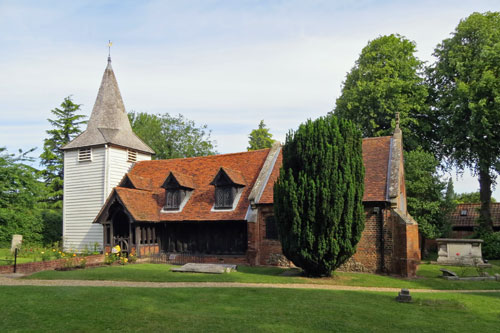
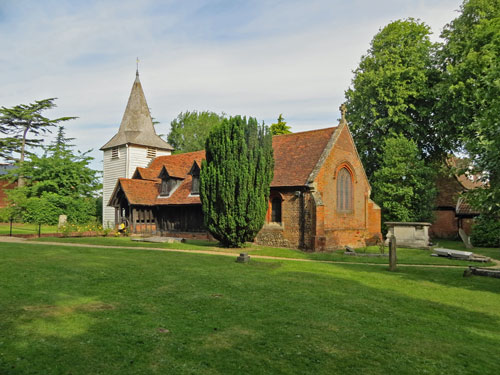
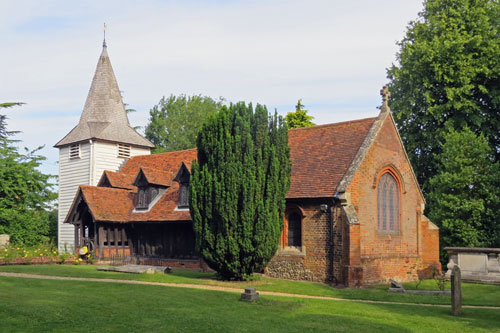
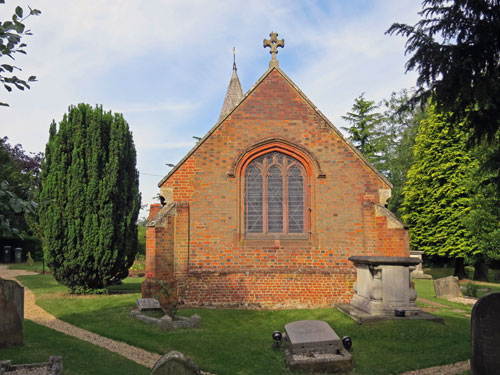
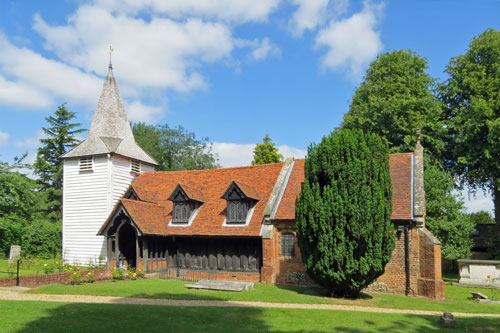
Greensted Saxon wooden church
details
Photo: © Ian Boyle, 1st July 2013
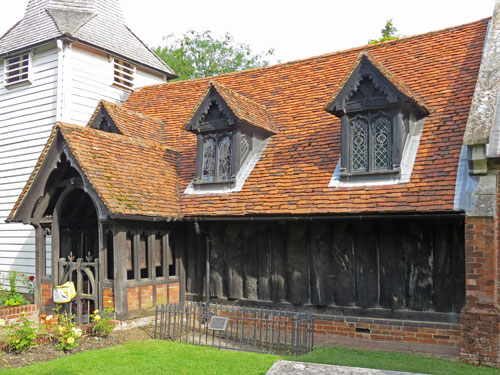
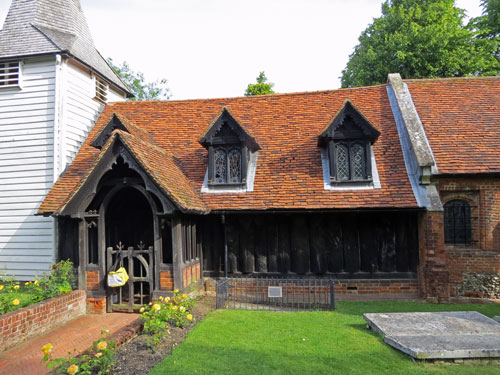

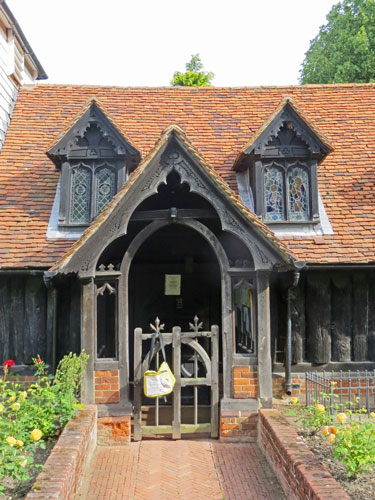
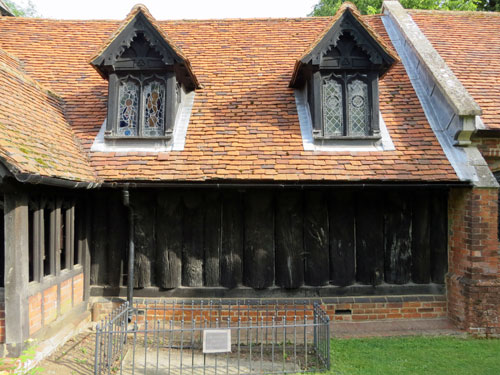
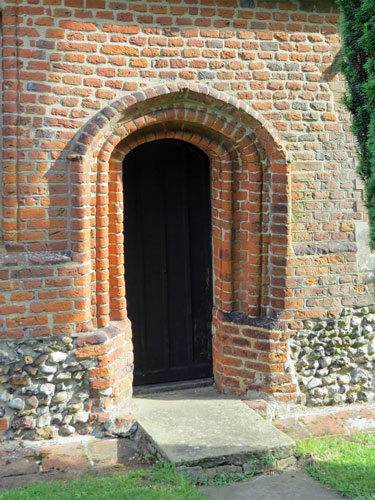
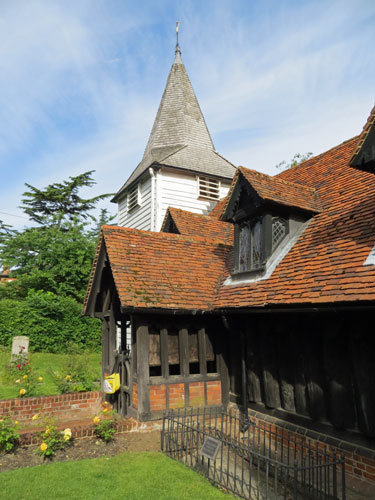
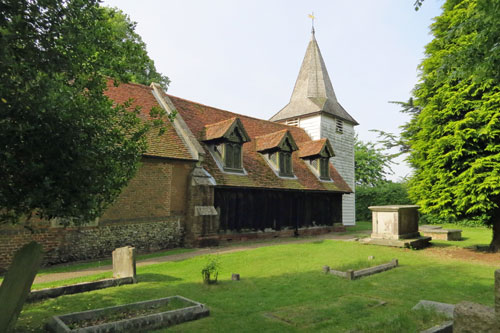
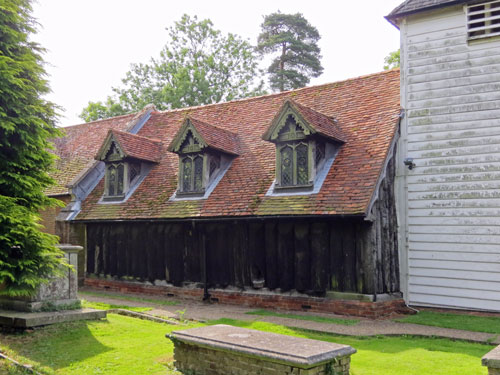
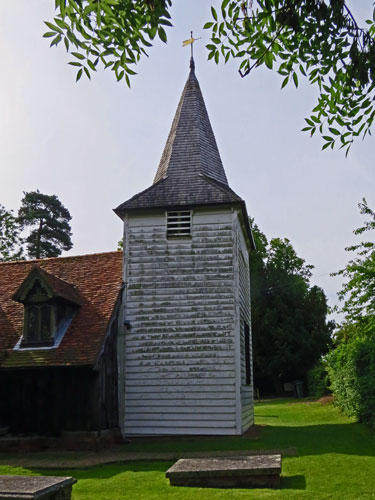
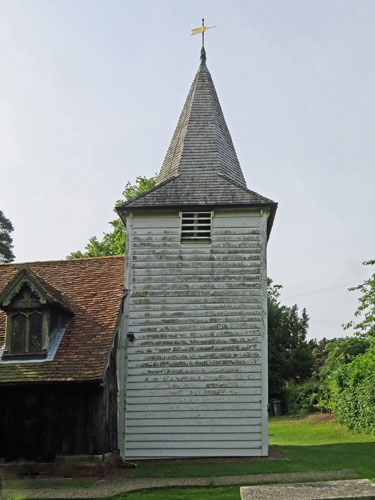
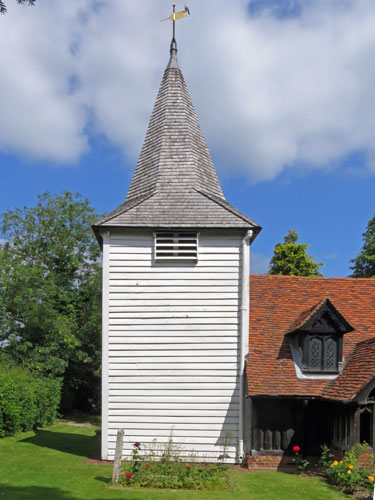
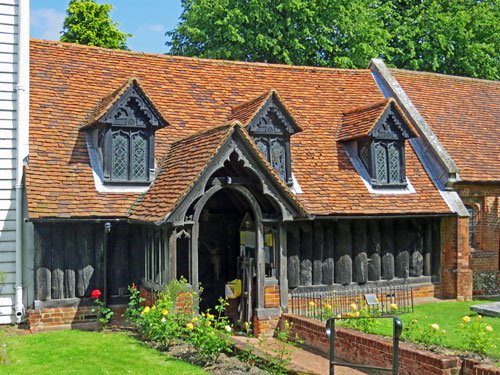
Greensted Saxon wooden church
interior with Tudor roof
Photo: © Ian Boyle, 1st July 2013
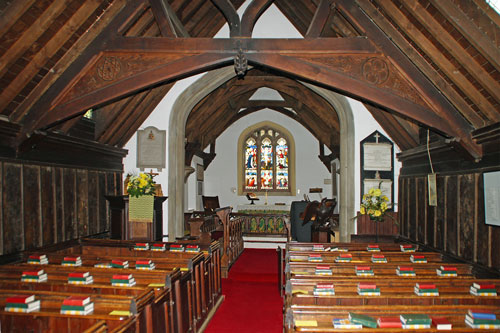
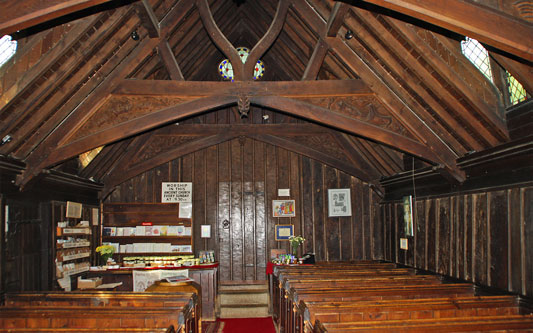
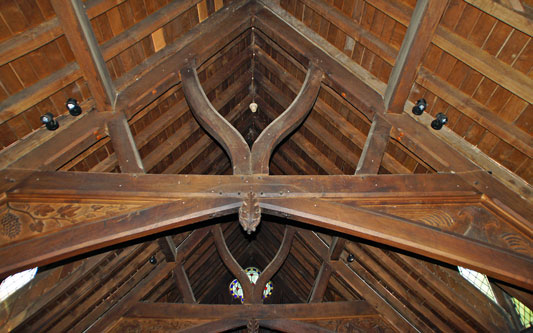
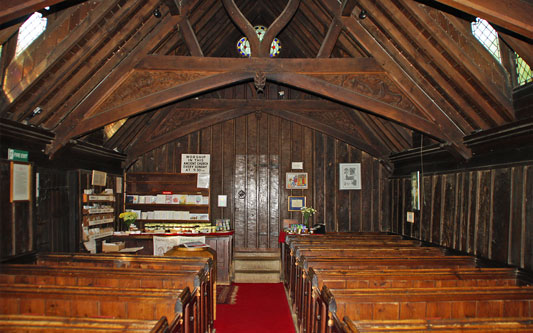
Greensted surroundings
Photo: © Ian Boyle, 1st July 2013

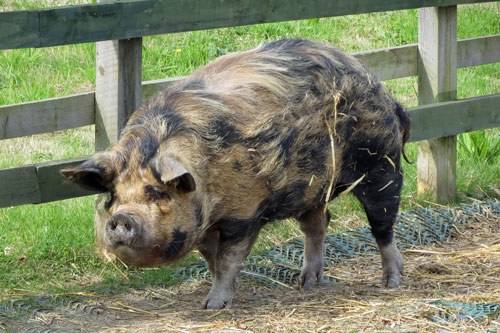
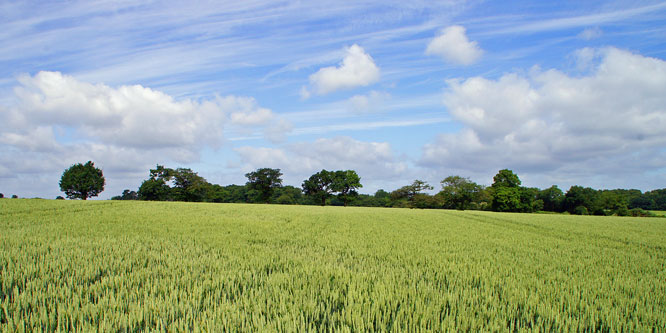
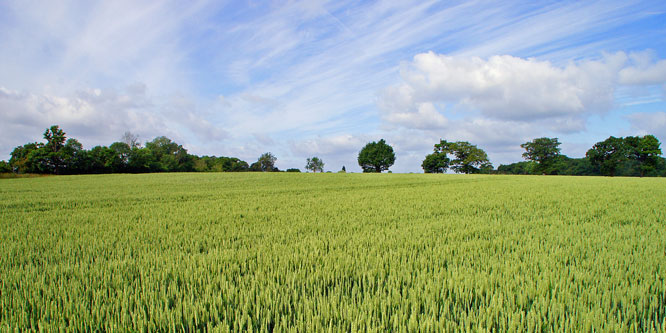
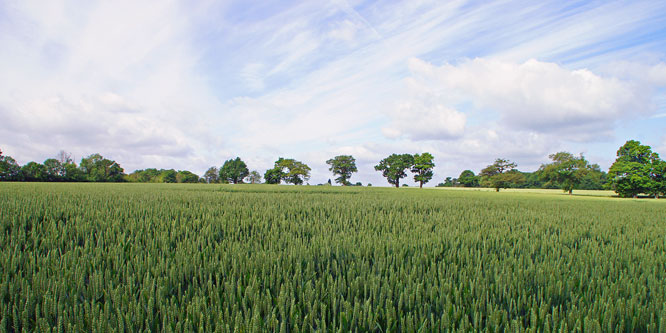
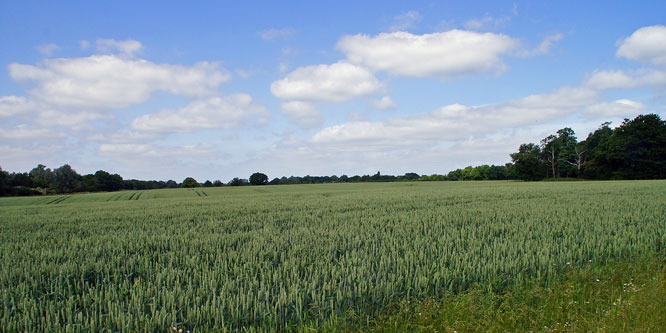

Public footpath across the
fields from Greensted Church to an Epping-Ongar Railway crossing
Photo: © Ian Boyle, 1st July 2013
